| |
|
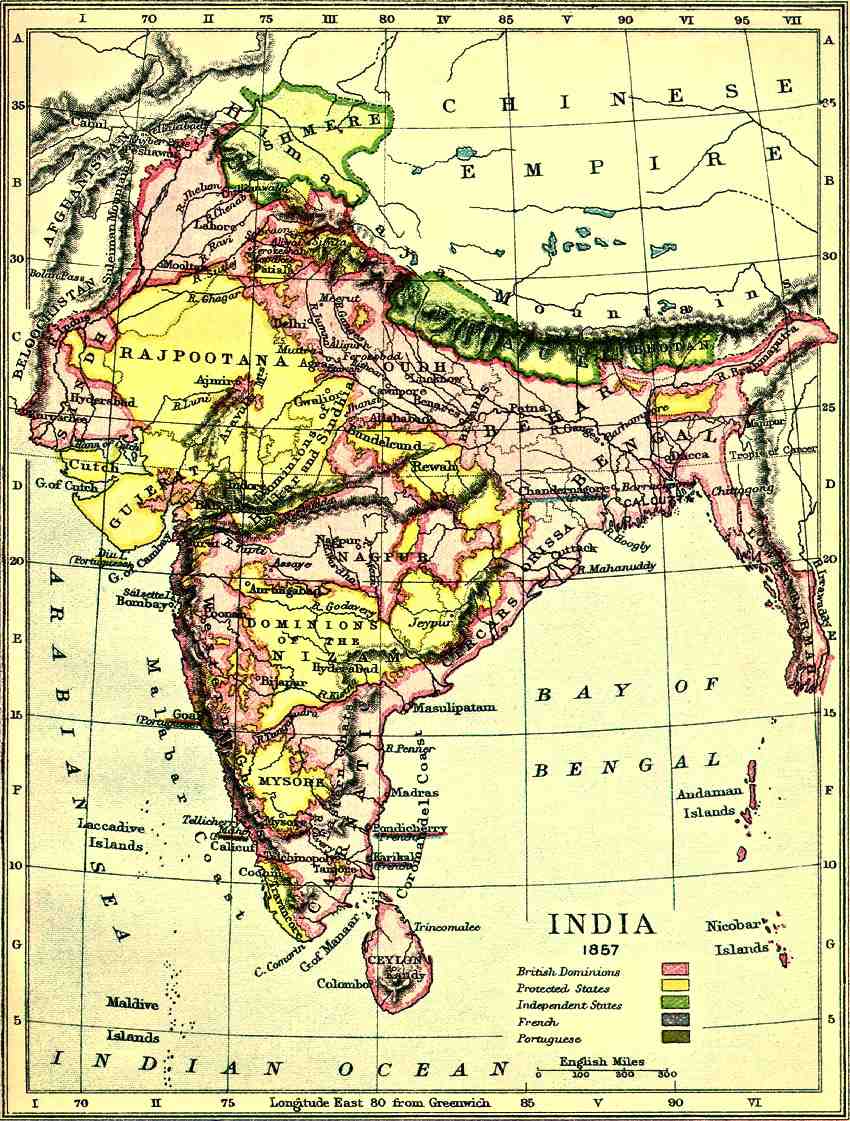
India 1857 |
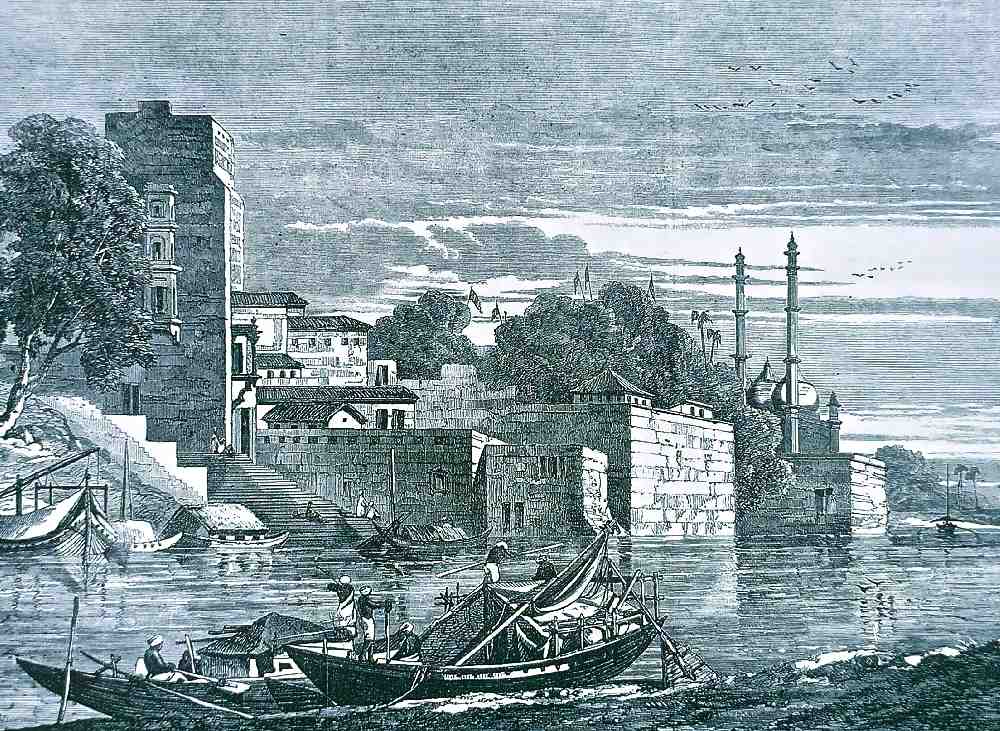
Ganges River |
|

The East India Company is, or rather
was, an anomaly without a parallel in the history of the world. It
originated from subscriptions, trifling in amount, of a few private
individuals. It gradually became a commercial body with gigantic
resources, and by the force of unforeseen circumstances assumed the form
of a sovereign power. — Bentley's Miscellany (1858)
The East India Company was a massive export company that was the
force behind much of the colonization of India. The power of the East
India Company took nearly 150 years to build. As early as 1693, the
annual expenditure in political "gifts" to men in power reached nearly
90,000 pounds. In bribing the Government, the East India Company was
allowed to operate in overseas markets despite the fact that the cheap
imports of South Asian silk, cotton, and other products hurt domestic
business. By 1767, the Company was forced into an agreement that it
should pay 400,000 pounds into the National Exchequer annually. |
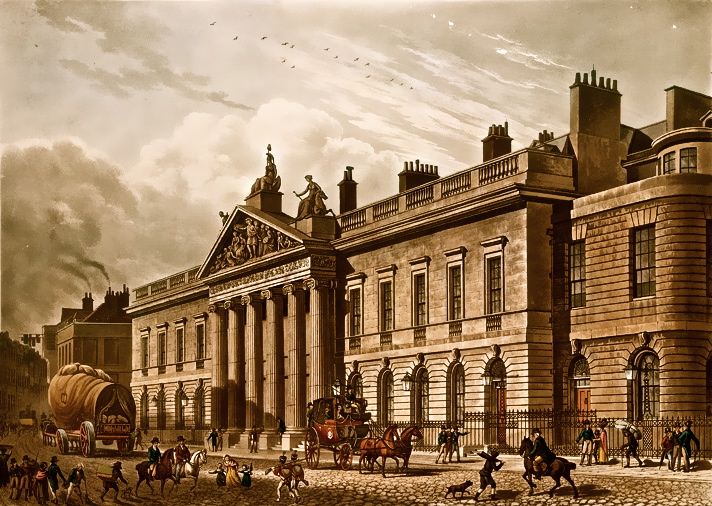
East India House - Leadenhall Street, London (1817) |
| The Company was just as adept at playing politics abroad. It
distributed bribes liberally: the merchants offered to provide an
English virgin for the Sultan of Achin's harem, for example, before
James I intervened. And where it could not bribe it bullied, using
soldiers paid for by Indian taxes to duff up recalcitrant rulers. Yet it
recognized that its most powerful bargaining chip, both home and abroad,
was its ability to provide temporarily embarrassed rulers with the money
they needed to pay their bills.
|
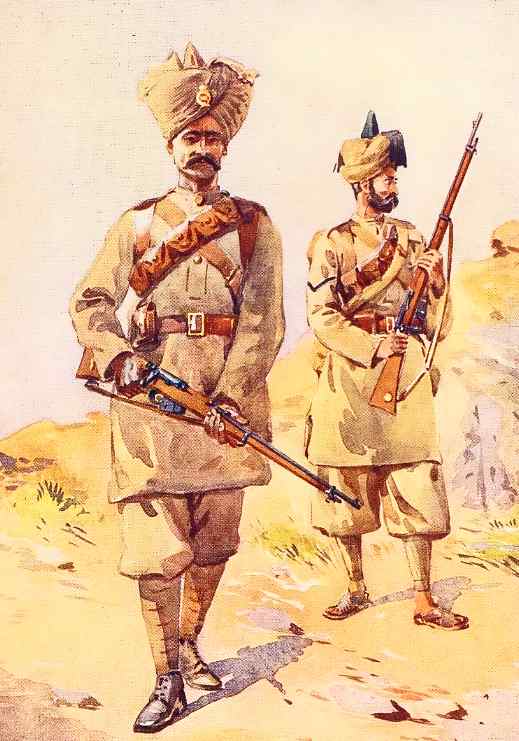 |

In January 1857, at the Dum Arsenal near Calcutta, an
Indian Lascar (sailor) asked a Brahmin Sepoy (infantryman) for a drink
of water from his brass cup. The Brahmin refused to share his cup; to
share his cup with a Lascar would contaminate it because of the Lascar’s
lower caste. In anger, the Lascar declared that the Brahmin would lose
his caste anyway when he used his new Enfield Rifles because the
cartridges contained animal fat from both pork and beef. This
announcement alarmed the Brahmin who confided his fears to his fellow Sepoys.
For a long time unrest and discontent had been rife
throughout India due to various territorial annexations, dethronements
of rulers, and other injustices on the part of the East India Company.
The revolt was mainly confined to the Company's Bengal Army, and its
immediate cause was the introduction of cartridges lubricated with pigs'
and cows' fat, and therefore taboo to both Moslems and Hindus.
Eating pig flesh is an abomination to Muslims, and the Hindu religion
regards the cow as sacred and therefore banned the consumption of its
flesh. Withdrawal of the cartridges did not remove the unrest, and on May 10th,
1857, the native garrison at
Meerut, the largest military station in
India, released eighty-five of their comrades who were in jail for
refusing to use the cartridges. After killing some of the British
officers and their families, the mutineers rode to Delhi. |
|
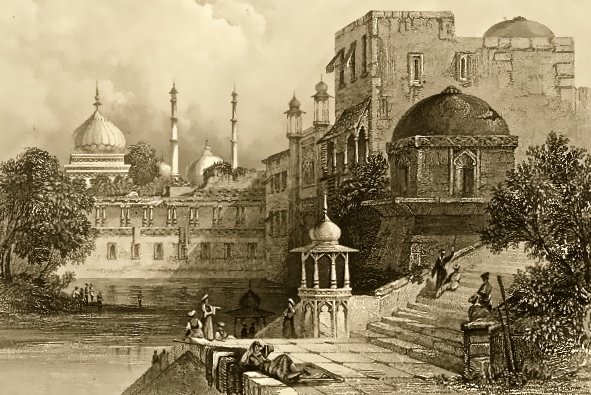

By 1857, the Mogul dynasty had withered to the point of
near extinction. The last of the Moguls, Bahadur Shah II, 'King of
Delhi', was a frail, opium-addicted old man deprived of any real power.
A pensioner of the British, he was king in name only, and it was
understood that upon his death his title would no longer exist.
|
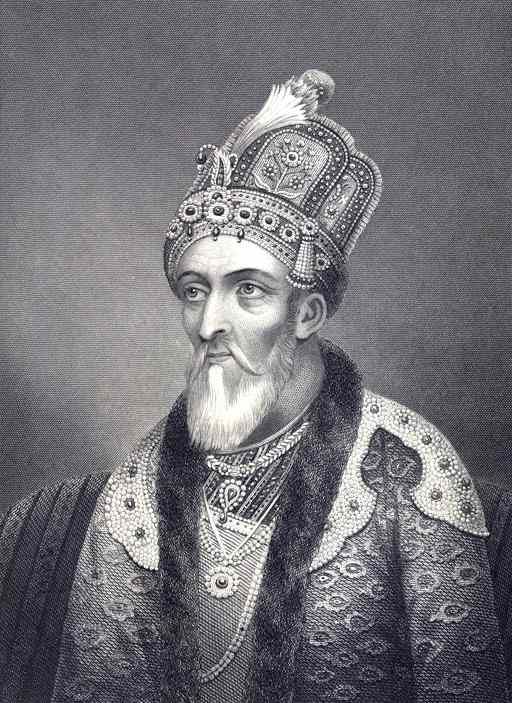
Bahadur Shah II - King of Delhi (Last
Mogul Emperor of India) |
| In the early hours of May 11, 1857, the King was jarred from his rest
when news flashed through the court that the 3rd Native Cavalry from the
nearby Meerut cantonment had dashed to Delhi and entered the city by the
bridge over the Jumna River. |
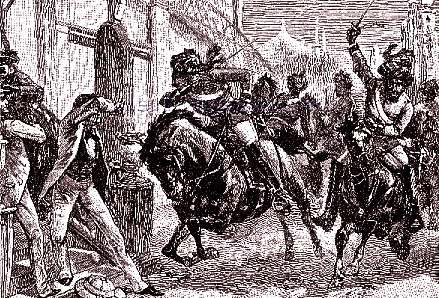
Mounted Rebel Sepoys - Delhi |
Bahadur Shah was hesitant to accept leadership of the
uprising. It would mean exchanging a peaceful life that permitted him to
write poetry in his luxurious palace for a life promising only risk and
turmoil. But he had no choice, because he was, in effect, a prisoner of the
mutineers. The 3rd Cavalry, now running wild in Delhi, would inevitably
be joined by all native units in northern India, he was told.
The native garrison at Delhi joined them, proclaimed the King of Delhi
as Emperor of India, and massacred the British residents. That attack
was only the beginning. Massacres, including the killing of women and
children, erupted throughout Delhi. Many of the resident British army
officers and civilians were hunted down and murdered on the streets of
the city.
Now titled the Emperor of Hindustan, Bahadur Shah did not intervene when
a group of Europeans who had sought sanctuary in his palace were
butchered to death. A steady stream of mutineers from across Northern
India headed to the impressive walled city of Delhi. It seemed as if
they had indeed taken the East India Company by surprise. |
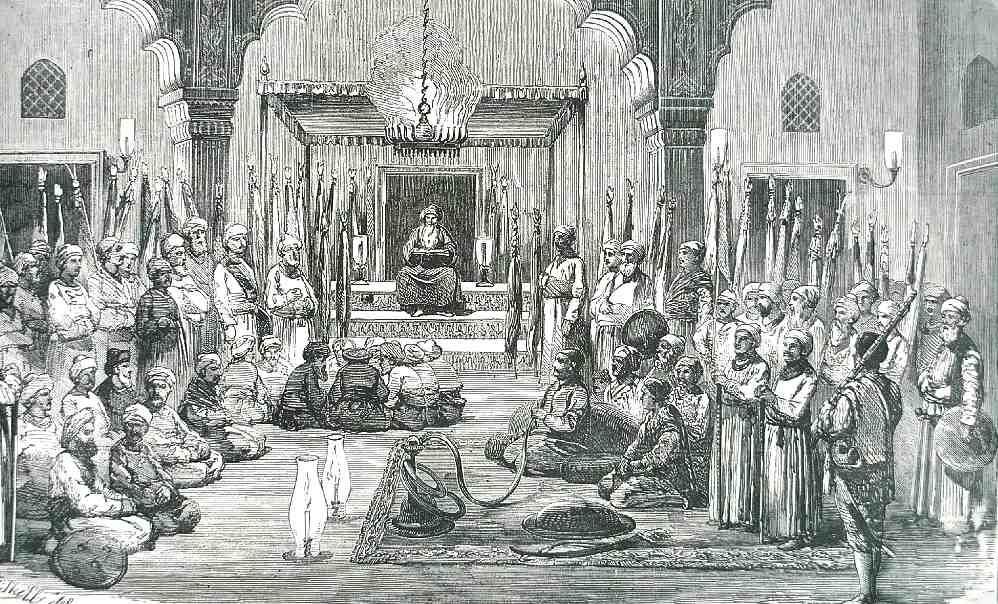 |
A small group of officers and men managed to stop the city arsenal
falling into mutineer hands, but only by blowing it to pieces. Several
hundred mutineers died in the conflagration, but some of the defenders
also shared the terrible fate.
Lieutenant Edward Vibart of the 54th Native Infantry, witness to this
tableau of horror, later described it, "The horrible truth now flashed
on me — we were being massacred right and left, without any means of
escape! I made for the ramp which leads from the courtyard to the
bastion above…Everyone appeared to be doing the same…the bullets
whistled past us like hail. To this day it is a perfect marvel to me how
any one of us escaped being hit."The rapid spread of the mutiny in
North India provoked unprecedented urgency in the British. Army
reinforcements were rushed from Rangoon, Ceylon and the Madras
Presidency in South India. |
|
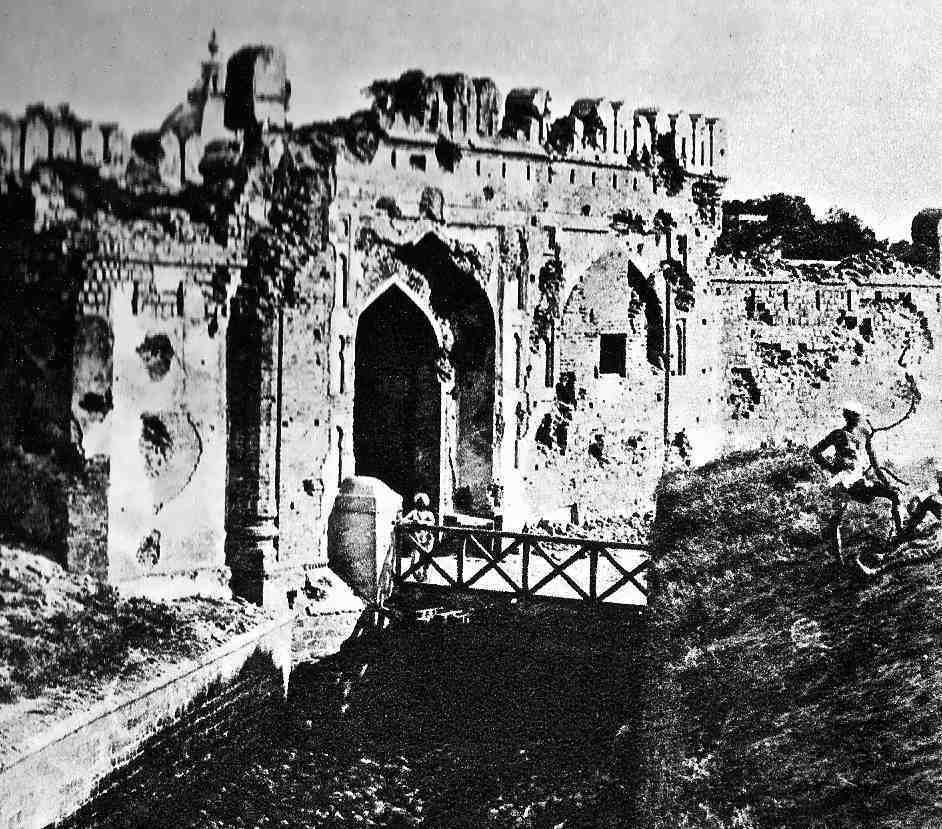
Siege of Delhi - Kashmir Gate . . 1857 |
The British regarded Delhi as particularly important for symbolic and
strategic reasons. If it was not soon retaken, the Punjab and Northwest
provinces might be encouraged to revolt. Sixteen years earlier, during
the First Afghan War, the Afghans had wiped out a British army, and with
it the myth of British invulnerability.
The city of Delhi was surrounded by 12-foot-thick walls and defended by
a few thousand well-trained Sepoys, although local volunteers up to a
total of perhaps 40,000 men supported them. The British had too few men
(approximately 10,000) to fully surround the city, so Indian
reinforcements and supplies were never cut off. Neither did the British,
at first, have sufficient artillery to breach the walls. Further, the
summer heat reached at times a reported 140 degrees.
The British occupied the old military cantonments outside the city, on
what was known as the Ridge. As a gesture of defiance, they burnt the
barracks - and left themselves without shelter from the grinding sun
which was to beat down upon them for over three months in the hottest
season of the Indian year. It was soon obvious that the British were not
strong enough to take Delhi. The mutineers forces were
increasing every day as more and more reinforcements came in brigades of
cavalry and infantry, their regimental colors bearing the names of
British victories flying bravely, their bands blaring British marching
tunes.
June 23rd, 1857, the 100th anniversary of the British victory at the
Battle of Plassey, which had marked the completion and
consolidation of the British East India Company's control over India,
was a difficult day for the British. On this day, bazaar folklore had
it, the British Raj would be driven from the subcontinent. In what may
have been an attempt to fulfill that prophecy, the Sepoys launched a
particularly savage attack on the Ridge. The British won the day,
however, driving the attackers back to their Delhi ramparts. |
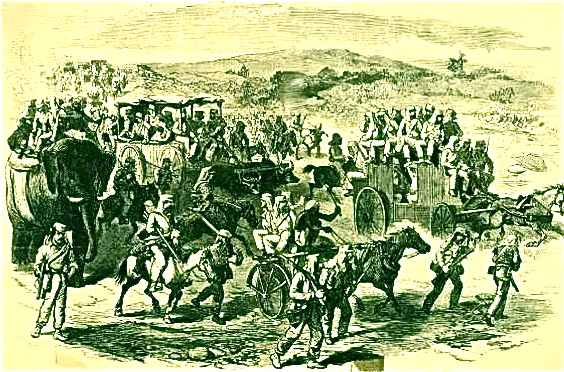
March to Delhi - 1857 |
The British had to have reinforcements and heavy artillery with
which to breach the walls of Delhi, and the reinforcements could only
come from the Punjab. A massive siege-train was organized; great guns
drawn by 16 elephants and accompanied by over 500 wagons loaded with
ammunition sufficient, it was confidently stated, "to grind Delhi to
powder."
General Sir George Anson, Commander-in-Chief India, received orders on
May 12th, 1857, to besiege Delhi. With considerable speed he organized
what became known as the Delhi Field Force. It consisted of the 9th
Lancers, the 75th (Gordon Highlanders), two Royal Horse Artillery
troops, the 1st and 2nd Bengal Fusiliers (European), 9th Light Cavalry,
and 4th Irregular Cavalry. Of the two native infantry regiments present,
one mutinied and cleared off to Delhi while the British disarmed the
other. At Baghpat, Colonel Archdale Wilson joined the Field Force with
the remnant of the Meerut garrison, consisting of two squadrons of the
6th Dragoon Guards and part of the 60th Rifles. On September 3rd and
4th, 1857, the British siege train arrived and began its work. |
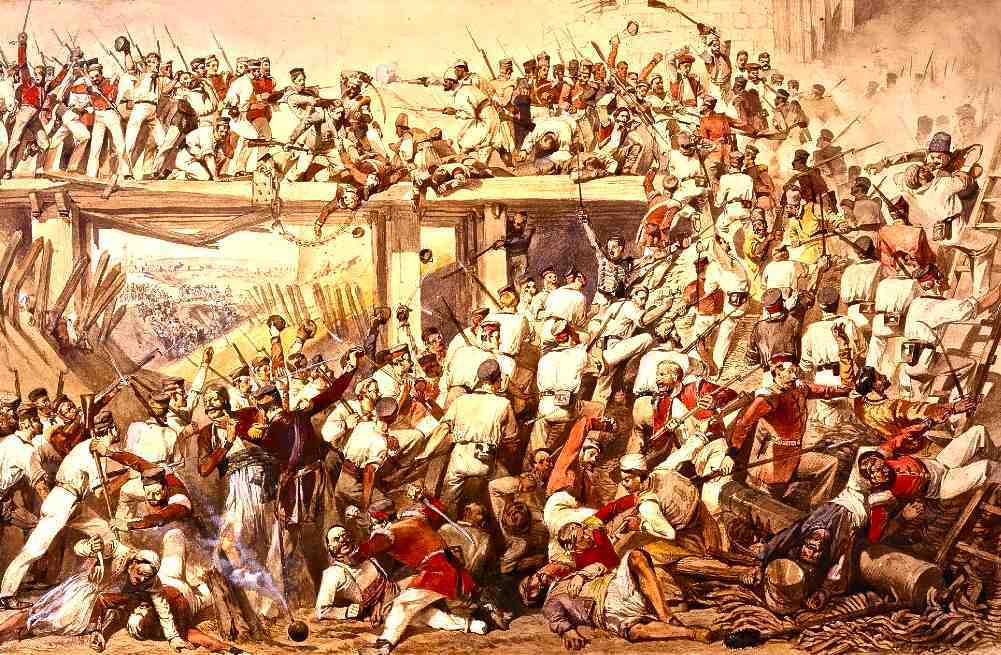
Kashmir Gate - September 14th, 1857 |
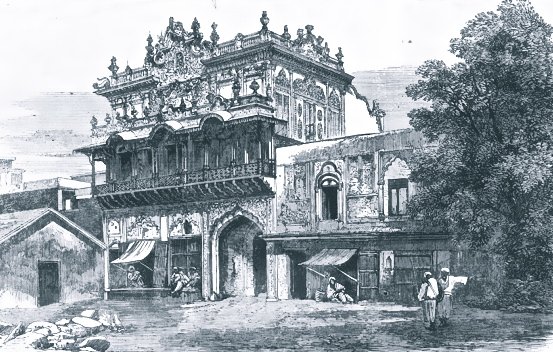
Lahore Gate |
Brigadier General Wilson, in command, ordered an assault for dawn on
the 14th of September, 1857. Four columns were to attack. Three columns
side by side would hit the northern walls at the Kashmir Gate, Kashmir
Bastion, and Water Bastion, while the fourth column would swing farther
south to try and force the Lahore Gate.
The attack got off to a bad start. The defending mutineers produced
deadly rifle and artillery fire, while men carrying the scaling ladders
could not keep up with the leading troops. The Kashmir Gate had to be
blown up by engineers, and that column wormed its way into the city
while the two other northern columns exploited the breaches. Once
inside, the three northern columns met near the Anglican church and set
up a perimeter. By day’s end almost 1,200 men had been killed or
wounded.
British troops found the magazine that had been blown up at the start of
the mutiny only partially damaged and a large store of artillery and
powder had survived. This allowed the force in the northern part of the
city to blast their way southwest to link up with the column attempting
to force the Lahore Gate. It had not been taken in the opening assault,
but finally fell to British forces on the 19th. That proved to be the
end of the mutineers’ resistance. On the 20th British troops blew open
the gates to the Red Castle to find the citadel deserted. Bahadur Shah
and his retainers had fled in the night. |
|
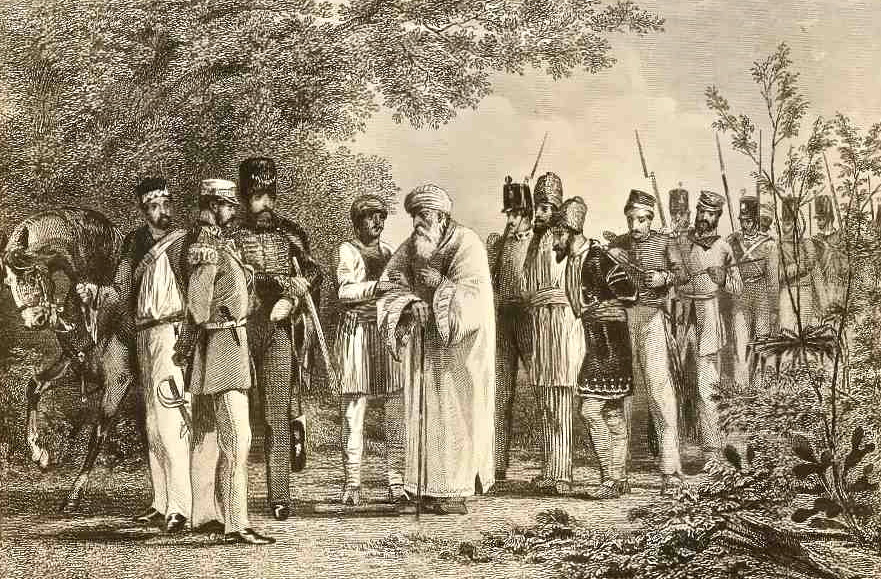
The "King of Delhi" Captured |
Bahadur Shah, disillusioned and tired of being manipulated by the
sepoys, had hidden a few miles north of the city in Emperor Homayun's
tomb. This was discovered by the intrepid but headstrong Major William
Hodson, who was famous along the Northwest Frontier as the leader of
hard-riding irregulars known as Hodson's Horse and who now managed
intelligence for the British at Delhi. With 50 of his men he set out on
September 21 to bring in the errant king.
Bahadur Shah had huddled inside the cloisters of the tomb while
thousands of his servants and well-wishers sullenly watched the
approaching British horsemen. The king knew that resistance on his part
would be pointless, and he accepted Hodson's promise that the major
would spare his life if he gave up quietly.
Followed by a vast entourage of Indians, Hodson led his captive back to
Delhi. Then, he and 100 of his irregular cavalrymen returned to
Homayun's tomb, this time to bring back the king's two sons and
grandson. Despite a mob of royal retainers and partisans, many of whom
were armed, Hodson was able to flush the young scions of the Mogul
dynasty from their hiding place. Hodson, surrounded by a hostile crowd,
did something that has ever since been criticized but may have saved his
life and those of his escort — he raised his carbine and summarily
executed the three princes. Amazingly, the shocked mob did nothing.
Hodson, as he had done many times before, stunned his adversaries into
submission by sheer audacity. The bodies were dumped unceremoniously at
the spot where the king's sons were thought to have committed atrocities
against the English. As the British chaplain observed, 'It was a dire
retribution.'
The seat of the once-great Mogul Empire was forever gone.
With the Delhi under control, 2,800 soldiers were dispatched to aid in
the relief of Lucknow. Although the mutiny went on for several more
months, the British recapture of Delhi marked their reconsolidation of
power.On September 14th, the day of assault, till the 20th, when
Delhi was completely under British possession, much looting took place
in the city. |
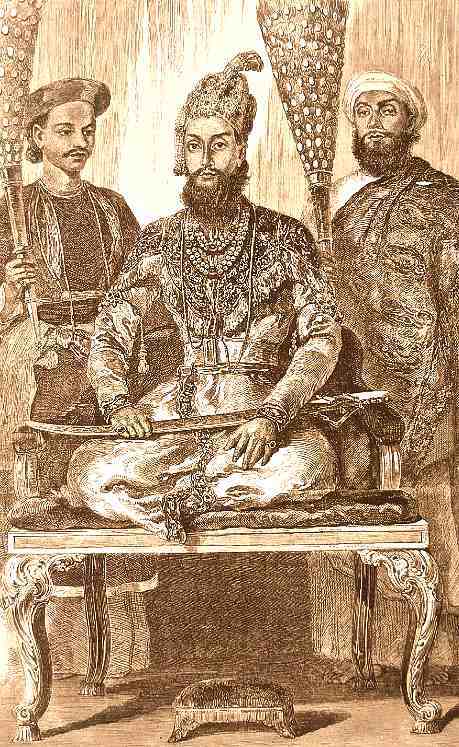
Eldest Son - King of Delhi |
| The troops, both European and native, and especially the Sikhs,
entered houses during those days and managed to secrete about their
persons articles of value. Also, many soldiers of the English regiments
got possession of jewelry and gold ornaments taken from the bodies of
the slain Sepoys and city inhabitants, including strings of pearls and
gold mohurs which had fallen into their hands. |
|
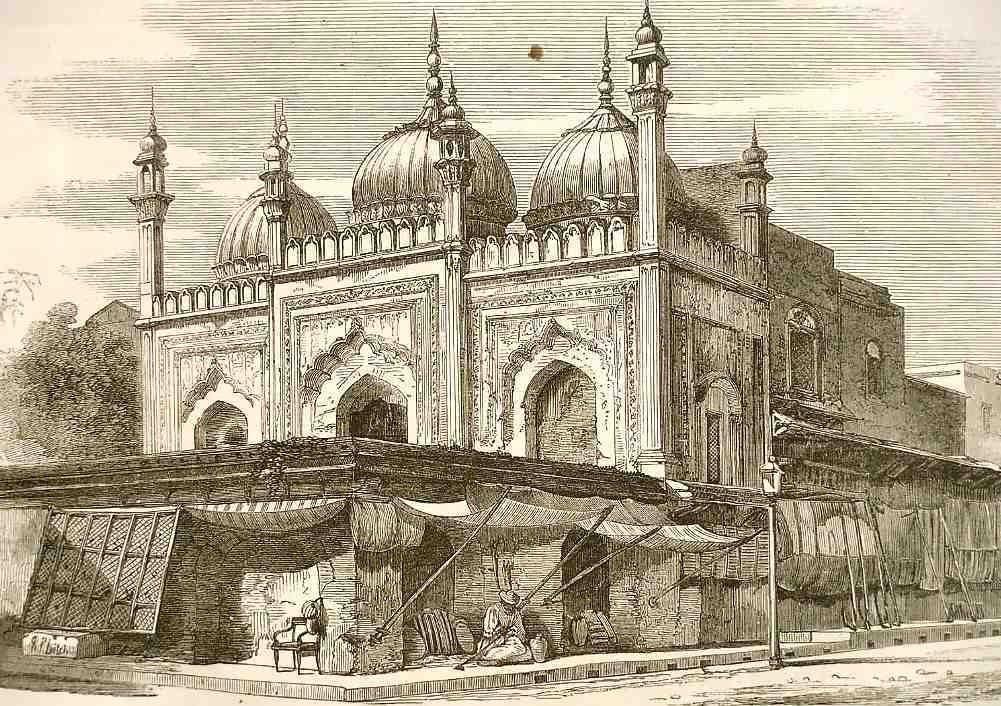
Mosque Roshun ad Dawla . . . circa
1857
Mosque Roshun ad Dawla, stands in the principal
street, and its pinnacles and domes are splendidly gilt. It is made
famous through its connection with an act of cruelty on the part of
Sheikh Nadir. This remarkable, but fearfully cruel monarch, on
conquering Delhi in the year 1739, had 100,000 of the inhabitants cut to
pieces, and is said to have sat upon a tower of this mosque to watch the
scene. The town was then set fire to and plundered. |
|
The gruesome story of the Siege of Cawnpore. On June 27th, 1857, in
Cawnpore, India, a British garrison with many women and children, under
siege, were offered safe passage and sanctuary. Instead, they were
betrayed and butchered. The surviving women and children were later
hacked to death. Retribution, when it came, was unrelentingly severe.
|
|
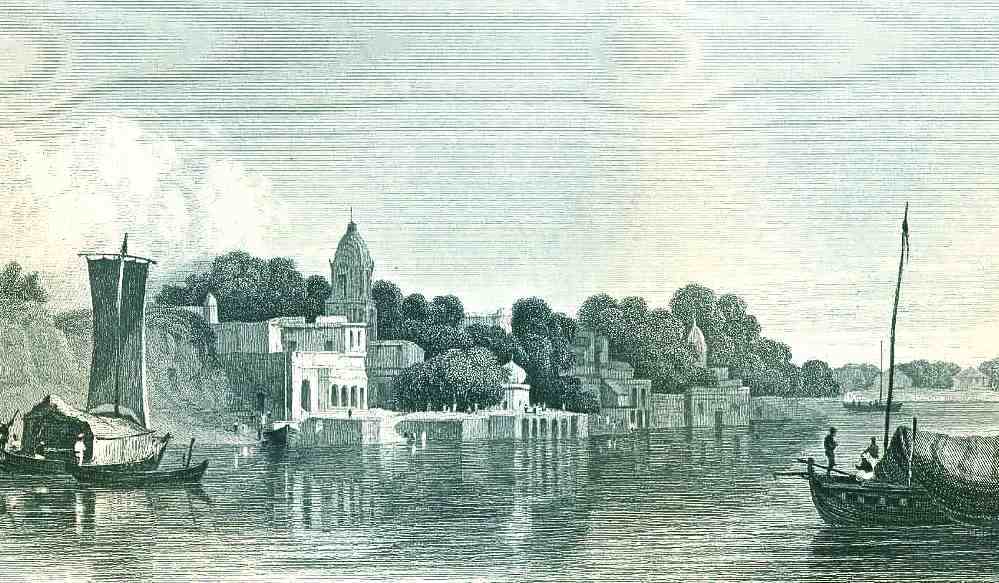
Cawnpore on the River Ganges |
| Cawnpore (modern Kanpur) is situated on the west side of the Ganges,
which is here more than a mile broad, and is crossed by a bridge of
boats. Cawnpore was in 1857 a major crossing point on the Ganges River,
and an important junction, where the Grand Trunk Road and the road from
Jhansi to Lucknow crossed.
Cawnpore became a vitally important garrison town, straddling key
communication lines. It lay on the approaches to the Punjab, Sind and
the newly acquired Oudh provinces. During a long series of years
Cawnpore had been one of the most important military stations in India.
There were few officers either of the Queen's or the East India
Company's Army who, during the period of their Eastern service, had not,
at some time or other, done duty in that vast cantonment. Unfortunately,
new conquests had denuded the encampment of many of its European
soldiers. It was thought that they were needed to help pacify the newly
acquired areas.
The Cawnpore Division was then commanded by General Sir Hugh Wheeler.
He was an old and a distinguished officer of the East India Company's
Army. He had seen much good service in Afghanistan and in the Punjab,
and had won his spurs under Gough in the second Sikh War. He had then
been in command of a division of Gough’s army. His fine military record
gave the Europeans in the area a reason to feel confident that the
mutiny might pass them by. Other than the East India Officers, the
European contingent was a strange collection of military families,
business owners, barbers, operators of toll roads, telegraphs and
railway engineers.
The station at Cawnpore was a large, straggling place, six or seven
miles in extent. There was nothing peculiar to Cawnpore in the fact that
the private dwelling houses and public offices of the English were
scattered about in the most random manner, as though they had fallen
from the sky. At the north-western extremity, lying between the road to
Bithii and the road to Dehli, were the principal houses of the
civilians, the Treasury, the Jail, and the Mission premises. These
buildings lay beyond the lines of the military cantonment, in the
extreme north-western corner of which, was the Magazine. In the centre,
between the city and the river, were the Church, the Theatre, the
Telegraph office, and other public edifices, whilst scattered about here
and there, without any apparent system, were the principal military
buildings, European and Native. The Native lines lying for the most part
in the rear towards the south-eastern point of the cantonment.
|
|
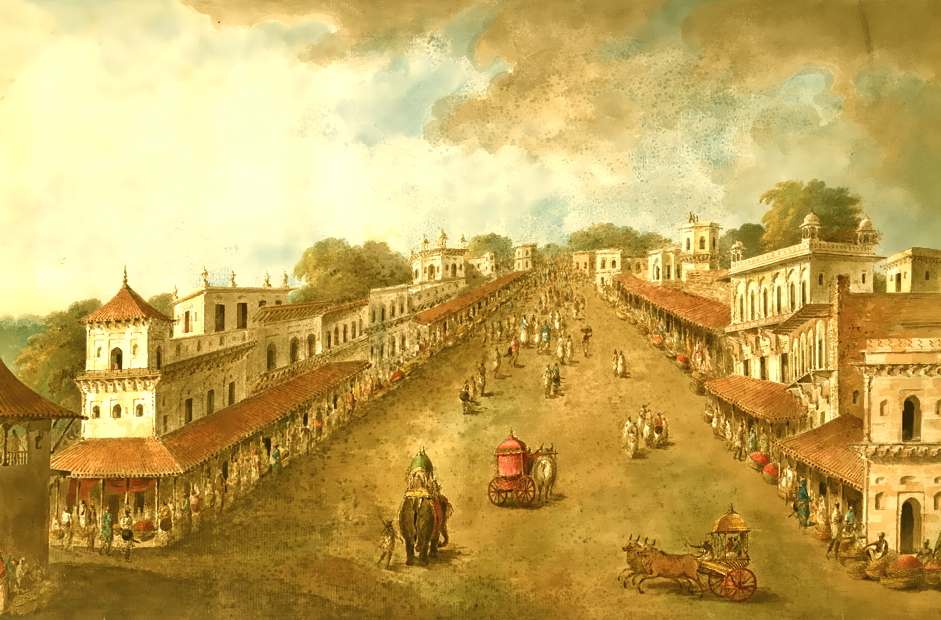
Cawnpore Street Scene . . . circa
1857 |
The city of Cawnpore had nothing in or about it to make it famous.
It had no venerable traditions, no ancient historical remains, or
architectural attractions, to enable it to rank with Banaras or Agra.
Commercially, it shone only as the city of workers-in-leather. It was a
great emporium for harness of all kinds, and for boots and shoes alike
of the Asiatic and the European types of civilization. If not better,
these articles were cheaper than elsewhere, and few English officers
passed through the place without supplying themselves with leather-ware.
But life and motion were never wanting to the place, especially on the
river-side, where many stirring signs of mercantile activity were ever
to be seen. The broad waters of the Ganges floated vessels of all sizes
and all shapes, some clustering about the landing-steps, busy with the
debarkation of produce and goods of varied kinds. People waiting for the
ferry boats that crossed and re-crossed the Ganges, were a motley
assemblage of different nations and different callings and different
costumes, whilst a continual babel of many voices rose from the excited
crowd. In the streets of the town itself there was little to evoke
remark. But perhaps, among its sixty thousand inhabitants, there may
have been, owing to its contiguity to the borders of Oudh, rather a
greater strength than common of the "rebellious types". |
|
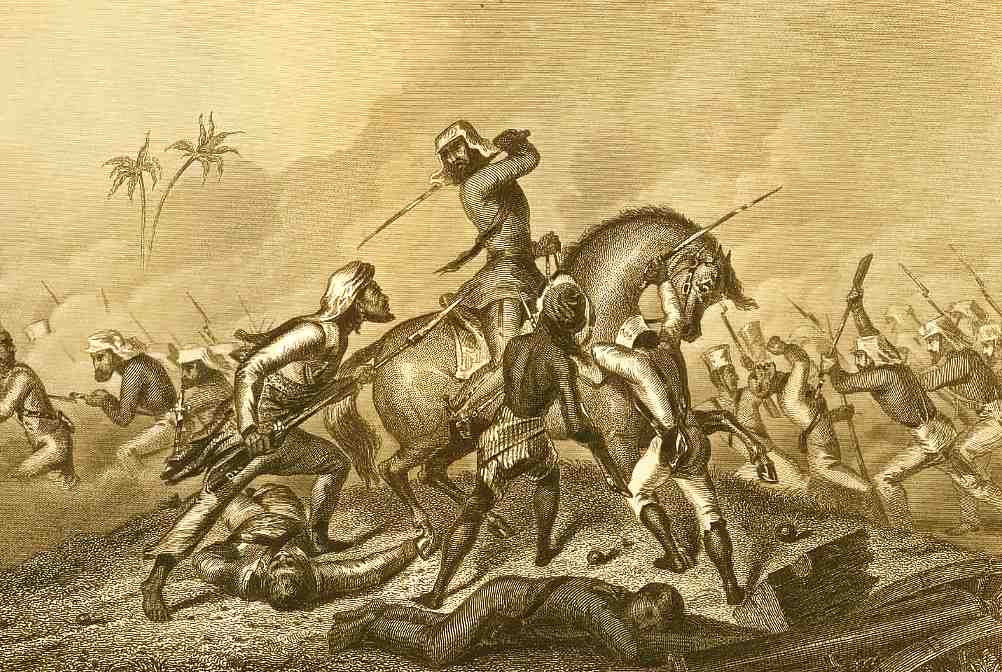
Cawnpore Mutiny |
| The story of the revolt at Meerut reached Sir Hugh Wheeler, and from
that date there reigned in his mind the conviction that a rising at
Cawnpore might take place at any moment. All that was needed, it then
appeared to General Wheeler, and to others, was a place of refuge, for a
little space, during the confusion that would arise on the first
outbreak of the military revolt, when, doubtless, there would be plunder
and devastation. It was felt that the Sepoys had at that time no craving
after European blood, and that their departure would enable General
Wheeler and his Europeans to march to Allahabad, taking all the
Christian people with them. |
Of all the defensible points in the Cantonment, the Magazine, in the
north-western comer of the military lines was best adapted for a
defensive position. It almost rested on the river, and it was surrounded
by walls of substantial masonry. But instead of this, Sir Hugh Wheeler
selected a spot about six miles lower down to the south-east, at some
distance from the river, and not far from the Sepoys' huts. There were
quarters of a kind for the British within two long hospital barracks
(one wholly of masonry, the other with a thatched roof). They were
single-storied buildings with verandahs running round them, and with the
usual outhouses attached. This spot General Wheeler began to entrench,
to fortify with artillery, and to provision with supplies of various
different kinds.
Wheeler pushed the fortifying and supplying of the two barracks with as
much speed as possible. The fortifications were to consist of
earthworks. But the rains had not fallen, the soil of the plain was
baked almost to the consistency of iron, and the progress was
consequently slow. Whilst laboring on these works, Sir Hugh communicated
freely with the civil authorities at the station, with Sir Henry
Lawrence at Lucknow, and with the Government at Calcutta.
Wheeler, feeling that the storm might burst at any moment, pushed on
with all his energy the preparation of the barracks. His spies told him
that every night meetings of an insurrectionary character were taking
place in the lines of the Native Sepoys. In ordinary times these
meetings would have been stopped with a high hand, but the example of
Meerut had forestalled that action. Besides, General Wheeler had but
sixty-one men to depend upon. Then, on May 21st, 1857, he received
information that the Sepoys would rise that night. He accordingly moved
all the women and children into the entrenchment, and attempted to have
the contents of the treasury conveyed thither, but the Sepoys would not
part with the money. |
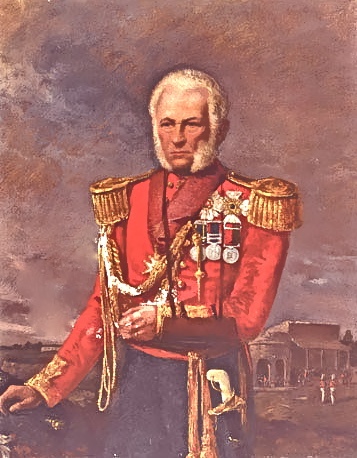
General Hugh Wheeler |
|
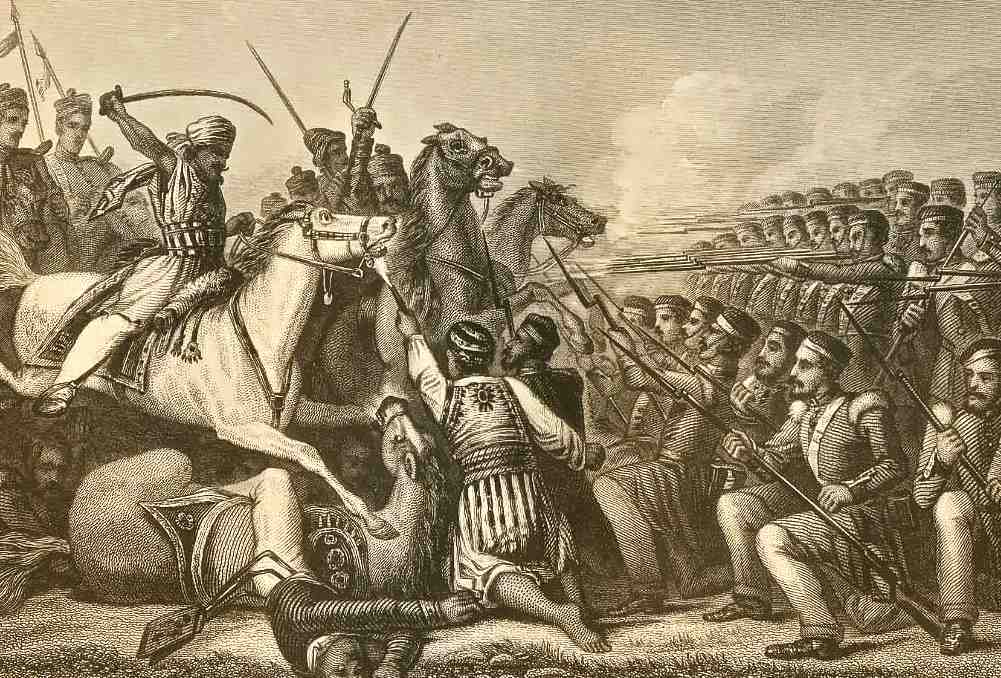
Cawnpore Battle_1857 |
| While these precautions were being taken, the General sent an
express to Lucknow requesting Sir Henry Lawrence to lend him, for a
while, a company or two of the 32nd Regiment, as he had reason to expect
an immediate rising at Cawnpore. Little could Lawrence spare a single
man from the troublous capital of Oudh. He sent all that he could send,
some eighty-four men of the 32nd, Queen's, packed closely in such
wheeled carriages as could be mustered. He sent also two detachments of
the Oudh Horse to keep open the road between Cawnpore and Agra, and
render such other assistance as Irregular Horse, well commanded, can
accomplish. A party of Oudh Artillery accompanied them with two field
guns. |
| Dondu Pant Nana Sahib, a man apparently on friendly terms with General Wheeler
and his Indian wife, promised his loyalty in the conflict due to engulf
the British. Then it was that the General, much against the grain,
availed himself of an offer made by the Nana Sahib, and agreed that 200
of the Bithur chiefs men should be posted at Nuwdbganj, guarding the
treasury and the magazine.
So when danger threatened them, it appeared to the authorities at
Cawnpore that assistance might be obtained from Nana Sahib. He had an
abundance of money and all that money could purchase, including horses
and elephants and a large body of retainers, almost, indeed, a little
army of his own. He had been in friendly association with the British up
to this very time, and no one doubted that as he had the power, also he
had the will to be of substantial use to them in the hour of their
trouble. It was one of those strange revenges, with which the stream of
time is laden.
Nana Sahib lived near Cawnpore, in the town of Bithur. Nana Sahib was
the adopted heir of the last great Mahratta King Baji Rao, who, after
defeat by the British, had been settled in luxurious exile at Bithur.
For 33 years the British paid the Prince a lavish pension, but when he
died in1851, unfortunately for Nana Sahib, the East India Company
decided that Baji Rao's pension would die with him and would not be
passed on to any successors. Nana Sahib lobbied hard sending an envoy to
London, to petition the Queen directly, but to no avail. This
dispossessed Hindu aristocrat would play a dangerous double game before
deciding who to support in the mutiny.
On May 23rd, 1857, the reinforcements from Lucknow arrived. Fletcher
Hayes, amongst the relief force, graphically described the situation in
a private letter, "I never witnessed such a scene of confusion, fright,
and bad arrangement as the European barracks presented. Four guns were
in position loaded, with artillerymen in nightcaps with sidearms on,
hanging to the guns in groups, looking like melodramatic buccaneers."
|
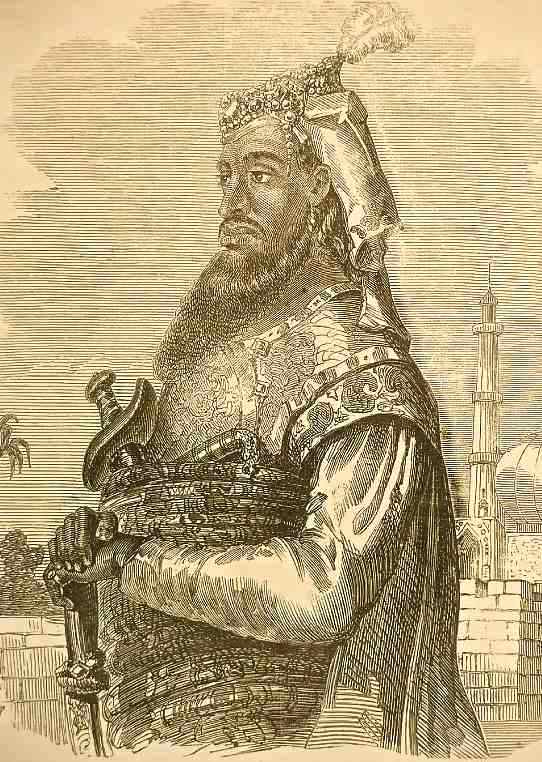
Nana Sahib |
| Hayes continued, "People of all kinds, of every color, sect, and
profession, were crowding into the barracks. Vehicles of all sorts drove
up and discharged a miscellaneous mob of every complexion, all in terror
of the imaginary foe; ladies sitting down at the rough mess-tables in
the barracks, women suckling infants, children in all directions, and
officers too!“ But during that last week of May, 1857, whatever plots
and perils might have been fermenting beneath the surface, outwardly
everything was calm and reassuring. And the brave old General began to
think that the worst was over, and that he would soon be able to assist
Sir Lawrence at Lucknow.
But everywhere in the Lines and in the Bazaars the plot was working. And
the plotters were not only there. Out at Nawabganj, where the retainers
of the Bithur were posted, were the germs of a cruel conspiracy.
During the first days of June, 1857, there were frequent meetings
between the chiefs of the rebellious Sepoys and the inmates of the
Bithur Palace. It was known to the soldiery before they broke into
rebellion that the Nana was with them, and that all his resources would
be thrown on the side of the nascent rebellion.
On the night of the June 4th, 1857, the 2nd Cavalry and the 1st
Infantry Regiment were ready for immediate action. The troopers had got
to horse and the foot soldiers were equipping themselves. As ever, the
former were the first to strike. There was a firing of pistols, with
perhaps no definite object. Then a conflagration which lit up the sky
and told the British in the entrenchments that the game of destruction
had commenced. Then, a mad nocturnal ride to Nawabganj, scenting the
treasure and the stores in the Magazine. The Regiment soon followed
them. The Sepoys did not wish to harm their officers, but they were bent
on rebellion. They hurried after the Cavalry, setting their faces
towards the north-west, where lay the Treasury, the Jail, and the
Magazine, with Dehli in the distance. As they went they burnt, and
plundered, and spread devastation along their line march, but left the
Christian people behind them, not lusting for their blood. |
|
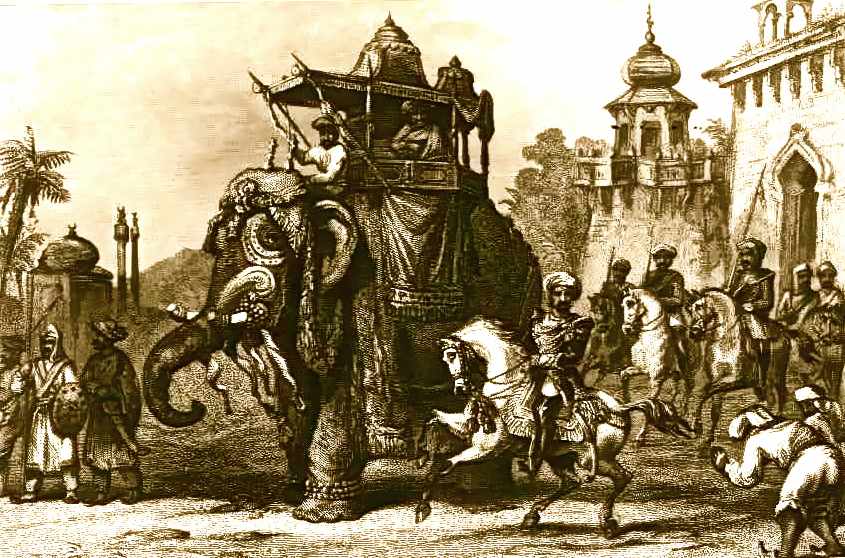 |
Arriving in the neighborhood of Nawabganj, the Sepoys of the two
regiments fraternized with the retainers of Nana Sahib and he announced
his loyalty to the mutiny and his desire to become a Hindu vassal of the
Muslim Moghul Empire. The Treasury was
sacked, the gates of the Jail were thrown open and the prisoners
released. The public offices were fired and the records burnt. The
Magazine, with all its supplies of ammunition, and the priceless wealth
of heavy artillery, fell into the hands of the Mutineers. The spoil was
heaped upon elephants and on carts, which the troopers had brought from
their Lines; and the one thought of the soldiery was a hurried march to
the great imperial centre of the rebellion, Delhi. The remaining
regiments joined them the following morning.
It was the plan of the Cawnpore mutineers to make their way straight to
Dehli, to join the regiments already assembled there, and to serve the
cause of the King. They had money and munitions of war and carriage for
the march, and they expected great tidings from the restored sovereignty
of the Moghul Emperor.
But Nana Sahib, stimulated by those about him, and chiefly, it is
thought, by the wily Muhammadan, Azimullah, looked askance at the
proposed centralization of the rebellion, and urged upon the Sepoy
leaders that something better might be done. They had made one march
towards the imperial city, but had halted at Kalianpur, whither the Nana
had accompanied them. Then they began to listen to the voice of the
charmer, and to waver in their resolution. The Bithur people might be
right they thought. It might be better to march back to Cawnpore. |
| Wise in his generation, the Nana Sahib saw clearly the danger of an
eclipse. To march to Dehli would be to place himself in a subordinate
position, perhaps to deprive him of all substantive authority. The
troops might desert him. The Emperor might repudiate him. In the
neighborhood of Cawnpore he would be supreme master of the situation. He
knew well the weakness of the English. He knew well that at Lucknow the
danger which beset the British was such that no assistance could be
looked for from that quarter, and that none of the large towns on the
Ganges offered any prospect of immediate relief. With four disciplined
Native regiments and all his Bithur retainers at his back, with guns and
great stores of ammunition and treasure in abundance, what might he not
do? At Kalianpur, therefore, the Nana arrested the march of the
mutineers to Dehli. It is not very clearly known what arguments and
persuasions were used by him or his ministers to induce the mutinous
regiments to turn back to Cawnpore. It is probable that they were
induced by promises of large gain.
Ominously for the British, the mutineers trundled back into town. This
time, they made sure that they had expunged all the Europeans from
outside of the entrenchment and systematically plundered and destroyed
all European owned property. Native Christians were also singled out for
gruesome fates. Whilst all this was happening Nana Sahib took the time
to write a letter to General Wheeler informing him to expect an attack
the next morning.
Only a few days before the regiments had broken into rebellion, Nana
Sahib had been in friendly and familiar intercourse with English
officers, veiling his hatred under the suavity of his manners and the
levity of his speech. But as day dawned on Saturday, the 6th of June,
Wheeler was startled by the receipt of a letter from Nana Sahib,
intimating that he was about to attack the entrenchments. There was not
an hour to be lost. Forth went the mandate for all the English to
concentrate themselves within the entrenchments. |
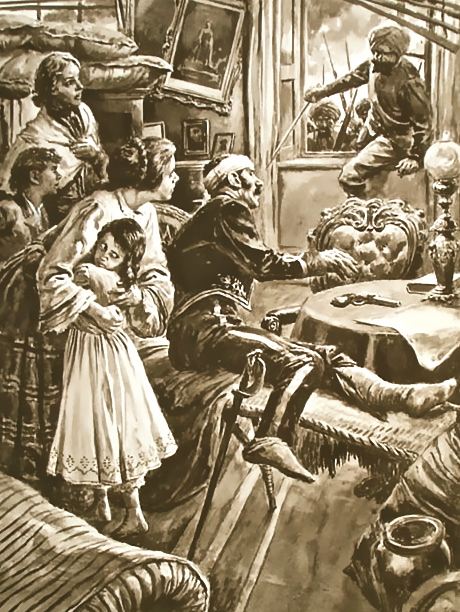 |
|
 |
|

Barracks Entrenchments |
| At 10:30 am on June 6th 1857, the rebel artillery opened up a
prolonged barrage signaling the start of the siege. The defenders could
not make an effective reply due to their smaller guns and the need to
keep canister shot loaded in case of a sudden charge. The siege of
Cawnpore was not a protracted affair. It lasted just over three weeks,
but it took place in June when the Indian sun is at its most merciless.
The June sky was little less than a great canopy of fire. The summer
breeze was as the blast of a furnace. To touch the barrel of a gun was
to recoil as from red-hot iron. Even under the fierce meridian sun, this
little band of English fighting men were ever straining to sustain the
strenuous activity of constant battle against fearful odds.
The Mutineers had an immense wealth of artillery. The Cawnpore Magazine
had sent forth vast supplies of guns and ammunition. And now the heavy
ordnance of the Government was raking the British with a destructiveness
which soon diminished the numbers working in the trenches. The English
artillerymen dropped at their guns, until one after another the places
of the trained gunners were filled by volunteers and amateurs, with
stout hearts but untutored eyes, and the lighter metal of their guns
could make no adequate response to the heavy fire of the Mutineers’
twenty-four pounders. |
Many in the entrenchments, not bred to arms, started suddenly into
stalwart soldiers. Among them were some railway engineers, potent to do
and strong to endure, who flung themselves into the work of the defense,
and made manifest to their assailants that they were men of the warrior
caste, although they wore no uniforms on their backs. Conspicuous among
them was Mr. Ileberden, who was riddled with grape-shot, and lay for
many days, face downwards, in extreme agony, which he bore with
unremitting fortitude until death came to his relief.
After the siege had lasted about a week a great calamity befell the
garrison. In the two barracks gathered together all the feeble and
infirm, the old and the sick, the women and the children. One of the
buildings had a thatched roof, and, whilst all sorts of projectiles and
combustibles were flying about, its ignition could be only a question of
time. Every effort had been made to cover the thatch with loose tiles or
bricks, but the" protection thus afforded was insufficient, and one
evening the whole building was in a blaze. The scene that ensued was one
of the most terrible in the entire history of the siege, for the sick
and wounded who lay there, too feeble and helpless to save themselves,
were in peril of being burnt to death. To their comrades it was a work
of danger and difficulty to rescue them, for the Mutineers, rejoicing in
their success, poured shot and shell in a continuous stream upon the
burning pile, which guided their fire through the darkness of the night.
The destruction of the barrack was a heavy blow to the besieged. It
deprived numbers of women and children of all shelter, and sent them out
houseless to lay day after day and night after night upon the bare
ground, without more shelter than could be afforded by strips of canvas
and scraps of wine-chests, feeble defenses against the climate, which
were soon destroyed by the unceasing fire of the enemy. |
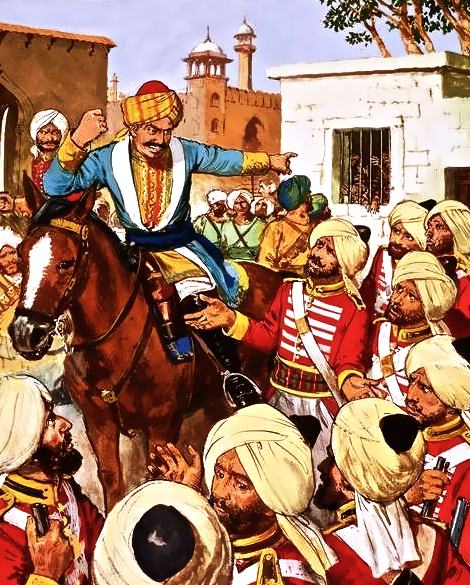 |
| There was another result of this conflagration. The few faithful
Sepoys who cast in their lot with their English officers, and
accompanied them within the entrenchments, had been told to find shelter
in this barrack. The 53rd Regiment sent ten Native officers, with
faithful Sepoys, into General Wheeler's camp. All the other regiments
contributed their quota to the garrison, and there is evidence that
during the first week of the siege they rendered good service to the
English. But, when the barrack was destroyed, there was no place for
them. Provisions were already falling short, and, although there was no
reason to mistrust, it was felt that they were rather an encumbrance
than an assistance. So they were told that they might depart. Although
there was danger beyond the entrenchments, there was greater danger
within them, and they not reluctantly perhaps turned their faces towards
their homes.
The General's son and aide-de-camp, Lieutenant Wheeler, was lying
wounded in one of the barrack-rooms, when, in the presence of his whole
family, father, mother, and sisters, a round shot boomed into the
apartment, and carried off the young soldier's head!
There was a well a little way outside the entrenchments, which served
as the general cemetery of the Christian people, and night after night
the carnage of the day was carried to this universal mausoleum. And
there were some who died hopelessly, though not in the flesh, for the
horrors of the siege were greater than they could bear, and madness fell
upon them, perhaps as a merciful dispensation. It is known that in the
space of three weeks the English consigned to the well two hundred and
fifty of their party. The number of bodies buried by the insurgents, or
devoured by the vultures and jackals, must have been at this amount many
times told. If hands were scarce in the entrenchments, muskets were not,
and every man stood to his work with some spare pieces ready-loaded,
which he fired with rapidity.
It was the centenary of the Battle of Plassey (June 23rd, 1757). On
the previous night there had been signs of extraordinary activity in the
enemy's ranks, and a meditated attack on the outposts had been thwarted.
As the morning of the 23rd dawned upon Cawnpore, the insurgents,
stimulated to the utmost by the associations of the day (legend called
for the defeat of the British 100 years after Plassey), came out in full
force of Horse, Foot, and Artillery, flushed with the thought of certain
success, determined to attack both outposts and entrenchments.
There was a stern resolution, in many cases strengthened by oaths on the
Ganges-water or the Koran, to destroy the English or to die in the
attempt. The excitement of all branches of the rebel-army was at its
highest pitch. The impetuosity of the Cavalry far exceeded their
discretion, for they galloped forward furiously within reach of the
British guns, and met with such a reception, that many horses were left
rider-less, and the troopers who escaped wheeled round and fled in
confusion. The Infantry, more cautious, improvised moving ramparts to
shelter their movement. They advanced huge bales of cotton, but the
British guns were too well served to suffer this device to be of much
use to the enemy, for some well-directed shots from the batteries set
fire to these defenses, and the assault was defeated. |
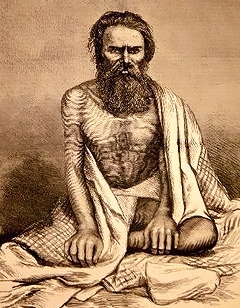
Nana Sahib |
The attack on the outer barracks was equally unsuccessful. The enemy
swarmed beneath the defense walls, but were saluted with so hot a fire
that, in a little time, the seventeen defenders had laid one more than
their number dead at the doorway of the barrack.
But there was a more deadly foe than this enemy mass of Hindus and
Muhammadans to be encountered. The Nana Sahib perceived another source
of victory than that which lay in the number of his fighting men. For
hunger had begun to gnaw our little garrison. Food, which in happier
times would have been turned from with disgust, was seized with avidity
and devoured with relish. To the flesh-pots of the besieged no carrion
was unwelcome. A stray dog was turned into soup. An old horse, fit only
for the knackers, was converted into savory meat. And when glorious good
fortune brought a Brahmani Bull within the fire of the defenses, and
with difficulty the carcass of the animal was hauled into the
entrenchments, there was rejoicing as if a victory had been gained. But
in that fiery month of June the agonies of thirst were even greater than
the pangs of hunger. The well from which scant supplies of water were
drawn was a favorite mark for the Sepoy gunners. It was a service of
death to go to and fro with the bags and buckets which brought the
priceless moisture to the lips of the famished people. Strong men and
patient women thirsted in silence, but the moans of the wounded and the
wailings of the children was pitiable to hear. And so as day by day the
English people were wasting under these dire pangs of hunger and thirst,
the hopes of the Nana Sahib grew higher and higher, and he knew that the
end was approaching. |
Three weeks had now nearly passed away since the investment had
commenced. No further reinforcements had come to their assistance. Their
numbers were fearfully reduced. Their guns were becoming unserviceable.
Their ammunition was nearly expended, and starvation was staring them in
the face. To hold their position much longer was impossible. To cut
their way out of it, with all those women and children, was equally
impossible.
When thus, as it were at the last, there came to them a message from the
Nana Sahib, brought by the hands of a Christian woman. It was on a slip
of paper in the handwriting of Azimullah, and it was addressed "To the
subjects of Her Most Gracious Majesty Queen Victoria, all those who are
in no way connected with the acts of Lord Dalhousie, and are willing to
lay down their arms, shall receive a safe passage to Allahabad."
When they thought of the women and children, and of what might befall if
the overtures of Nana Sahib were rejected, the messenger carried back to
the enemy's camp an announcement that General Wheeler and his chief
officers were deliberating upon the offer that had been made to them.
Next morning (there was then an armistice), Azimullah and Jawala-l
arshad, presented themselves near the entrenchments, and Captain Moore
and others went out with power to treat with the emissaries of the Nana.
It was then proposed that the British should surrender their fortified
position, their guns, and their treasure, and that they should march out
with their arms and sixty rounds of ammunition in each man's pouch. On
his part, the Nana was to afford them safe conduct to the river side,
and sufficient carriage for the conveyance of the women and the
children, the wounded and the sick. Boats were to be in readiness at the
ghaut (flight of steps leading down to a river) to carry them down the
Ganges, and supplies of flour, sheep and goats also were to be laid in
for the sustenance of the party during the voyage to Allahabad.
These proposals were committed to paper and given to Azimullah, who laid
them before his chief, and that afternoon a horseman from the rebel camp
brought them back, saying that the Nana Sahib had agreed to them. |
|
 |
|
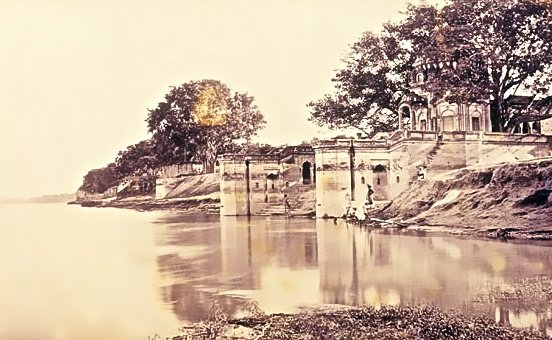 |
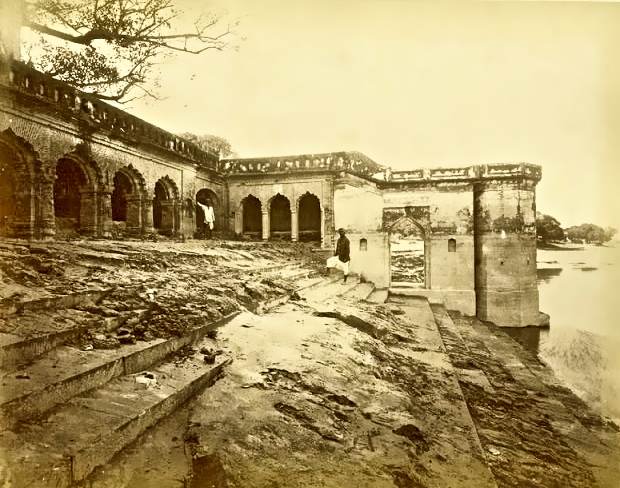 |
| On June 27th, 1857, from their entrenchments, in the early morning,
went the remnant of the garrison, with the women and the children, who
had outlived the horrors of the siege. They wore gaunt and tattered
garments, were emaciated and enfeebled by want, worn by suffering, some
wounded and scarred with the indelible marks of the battle upon them.
The river was distant only a mile from the defenses, but to them it was
a long journey. The wounded were carried mostly in palanquins. The women
and children went in rough native bullock carriages or on the backs of
elephants, whilst the able-bodied marched out on foot with but little
semblance of initial array. General Wheeler, with his wife and
daughters, are said to have walked down to the boats.
The place of embarkation was known as the Sati Chuara Ghaut, so
called from a ruined village near by which bore that name. The road ran
across a wooden bridge. Over this bridge they filed down into a ravine,
which led on to the river-side. Near the ghaut was a Hindu temple, known
as the Temple of Hardeo, or the Fisherman's Temple, a structure of
somewhat fanciful and picturesque design. The incidents of this
mile-march were not many.
At the place of embarkation, the uncouth vessels were seen a little way
off in the stream in shallow water, for it was the close of the dry
season and the river was at its lowest. The boats were the ordinary
eight-oared budgerows of the country. They were ungainly structures with
thatched roofs, looking at a distance like floating hay-stacks, and into
these the people began to crowd without order or method, even the women
with children in their arms, with but little help from others, wading
knee-deep in the water, and scrambling as they best could up the sides
of the vessels. It was nine o'clock before the whole were aboard the
vessels.
So foul an act of treachery was prepared by Dondu Pant Nana Sahib. The adopted son of the last of the Peshwa had studied to some purpose
the early history of his race. He knew how the founder of the Maratha
Empire, the head of the great family who had been the masters of the
Peshwas had, under false pretext of friendly embrace, dug his Vaknak
into the bowels of a Muhammadan envoy, and gained by foulest treachery
what he could not gain by force. The Vaknak was now ready - "Vaknak of a
Thousand Claws" in the hands of the man who aspired to be the founder of
a new or renovated Maratha Empire. ["Valcnak" or "Vagnak", is a weapon
made of five rings, to each of which is attached a steel claw, like that
of a tiger. The rings fit the fingers of the hand, and the claws lie
concealed in the palm, till the moment for striking arrives] |
|
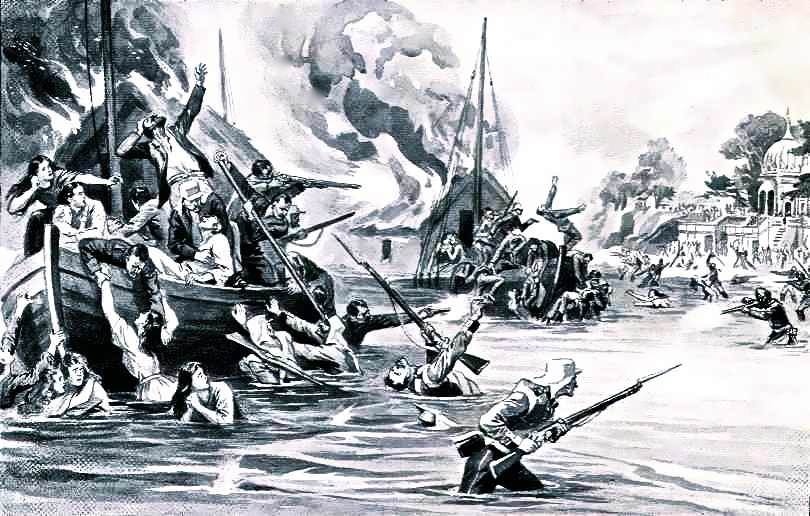 |
Everything was ready for the great carnage. Tantia Topi, who had
been appointed master of the ceremonies, sat enthroned on a "Chabutra"
or platform, of a Hindu temple, and issued his orders to his dependants.
Azimullah, also was there, and the brethren of the Nana Sahib, and Tika
Singh, the new Cavalry General, and others of the-leading men of the
Bithur party. And many Zemindars from the districts, and merchants and
lesser people from the city, are said to have gone forth and to have
lined the river banks to see the exodus of the English. Not knowing what
was to come. It looked like a great holiday show.
No sooner were the English people on board the boats, than the foul
design became apparent. The sound of a bugle was heard. The Native
boatmen clambered over the sides of the vessels and sought the shore.
Then a murderous fire of grapeshot and musket-balls was opened upon the
wretched passengers from both banks of the river, and presently the
thatch of the bugerows, cunningly ignited by hut cinders, burst into a
blaze. There was then only a choice of deaths for the Christians. The
men, or the foremost amongst them, strenuous in action to the last,
leaped overboard, and strove, with shoulders to the hulls of the boats,
to push them into mid-channel. But the bulk of the fleet remained
immovable, and the conflagration was spreading. The sick and wounded
were burnt to death, or more mercifully suffocated by the smoke, while
the stronger women, with children in their arms, took to the river to be
shot down in the water, to be sabre'd in the stream by the mounted
troopers who rode in after them, to be bayoneted on reaching land, or to
be made captives and reserved for a later and more cruel immolation.
While this terrible scene was being acted at the ghaut, the Nana
Sahib, having full faith in the malevolent activity of his lieutenants
on the riverbank, was awaiting the issue in his tent on the cantonment
plain. It is related of him that, unquiet in mind, he moved about,
pacing hither and thither, in spite of the indolence of his habits and
the obesity of his frame. After a while, tidings of the progress of the
massacre were brought to him by a mounted trooper. What had been passing
within him during those morning hours no can know. Perhaps some slight
spasm of remorse may have come upon him, or he may have thought that
better use might be made of some of British alive than dead. But,
whether moved by pity or by craft, he sent orders back by the messenger
that no more women and children should be slain, but that not an
Englishman was to be left alive. So the Mutineers, stayed their hands
and ceased from the slaughter. Probably one hundred and twenty-five half
drowned, all dripping with the water of the Ganges and begrimed with its
mud, were carried back in custody to Cawnpore, by the way they had come.
The hunting down of fleeing survivors occupied several days. All who had
not been burnt, bayoneted, sabre’d, or drowned in the great massacre of
the boats on the 27th of June, had been swept up and carried to the
Savada House. A building which had figured in the history of the siege.
For a time, it had been the head-quarters of the rebel leader. And now
these newly-made widows and orphans were added to the shuddering herd of
condemned innocents. Eighty was their number. They were brought back on
carts, and arrived on June 30th, 1857.
Delafosse, with privates Murphy and Sullivan, alone survived to reach
the territory of a friendly Eajah, and lived to tell the story of
Cawnpore. |
|
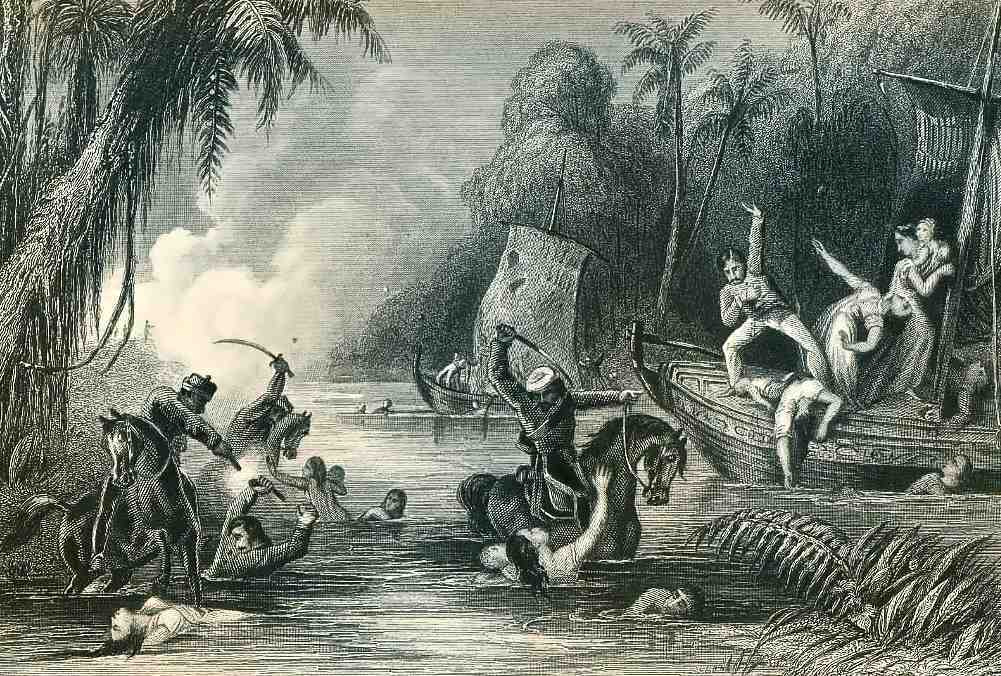 |
| The Nana Sahib, carrying with him an infinite satisfaction derived
from the success of his machinations, went off to his palace at Bithur.
Next day, in all the pride and pomp of power, he was publicly proclaimed
Peshwa. No formality, no ceremony was omitted, that could give dignity
to the occasion. He took his seat upon the throne. The sacrament of the
forehead-mark was duly performed. The cannon roared out its recognition
of the new ruler. And when night fell the darkness was dispersed by a
general illumination, and showers of fireworks lit up the sky. |
| But it was not long before, even in the first flush of triumph,
heaviness fell upon the restored sovereignty of the Peshwa. And news
soon reached Nana Sahib that in his absence from Cawnpore, his influence
was declining. The Muhammadan party was waxing strong. It had hitherto
been overborne by the Hindu power, probably more than all else for want
of an efficient leader. But there was a Muhammadan nobleman, known as
the Nani Nawab, who had taken a conspicuous, if not an active, part in
the siege. At the commencement of the outbreak he had been made prisoner
by the Nana Sahib, and his house had been plundered, but subsequently
they had entered into a covenant of friendship. He directed or presided
over one of the batteries planted at the Eacquet Court, daily driving
down to it in his carriage and sitting on a chair, in costly attire,
with a sword at his side and a telescope in his hand. There was no
battery that wrought the British greater mischief than Nani Nawab's.
Nana Nawab had got together some cunning Native artificers, who
experimented with red-hot shot and other combustibles, not without
damage to the lives of those working in the batteries. It was a
projectile from one of his guns, described as a ball of resin, which set
fire to the barrack in the entrenchments. Among the Muhammadans of the
neighborhood he was held in high estimation, and large numbers of
followers attended him as he went down every day to his battery.
And now there was some talk of setting up the Nawab as head of the new
Government. If this had been done, there would have been faction fights
between Hindus and Muhammadans.
Then other disturbing rumors reached him. The English reinforcements
were advancing from Allahabad, hot for revenge, eager for blood. The
story ran that the British soldiers were hanging every Native who came
in their way. A great fear was settling down upon the minds of the
inhabitants of Cawnpore. |
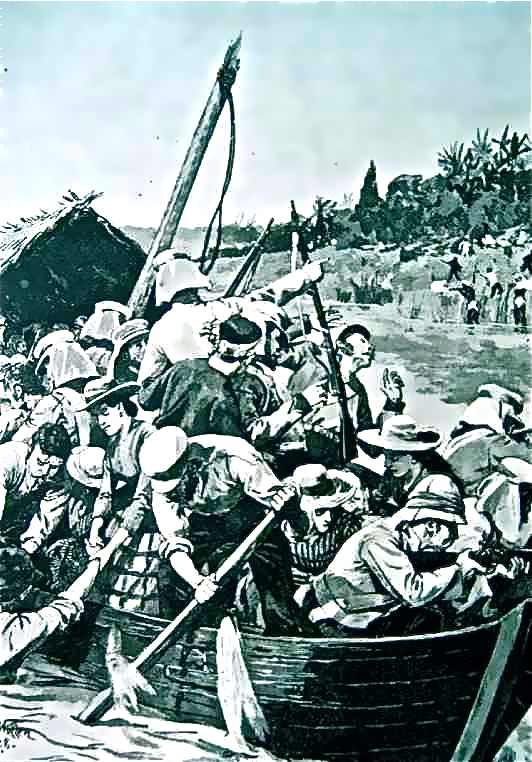 |
After the fashion of the East, he strove to drown his cares and
anxieties with music, and dancing, and stately appearances in public,
and he solaced himself in more retired hours, with strong drink and the
caresses of a famous courtesan.
But ever, as the month of July wore on, news came that the English were
advancing, and the Peshwa trembled as he heard, even in the midst of his
revelries. There was however, one more victory to be gained before the
collapse of the new Maratha power on the banks of the Ganges. And the
Nana Sahib smiled, as he thought that the game was all in his own hands. |
|
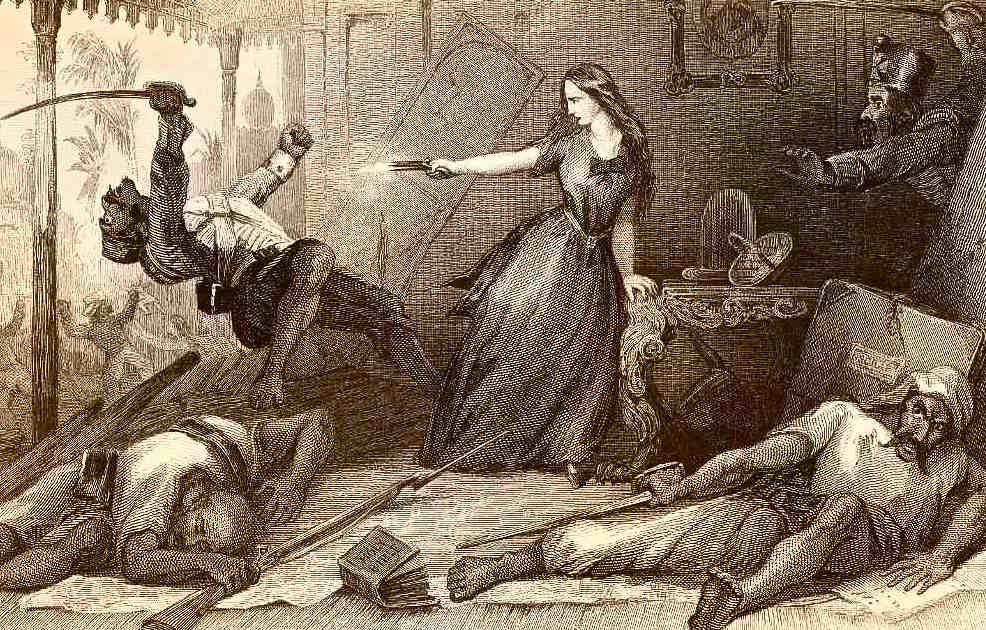
There was one remarkable escape
story that may have had a kernel of truth to it. As the Sati Chaura
massacre took place, a Sowar rode off with one of General Wheeler's
daughters slung over his saddle. It was believed (or rather hoped) that
she had slain her captor before he had his wicked way with her. This is
what this picture shows. However, the truth may have been that she was
indeed rescued by a Sowar named Ali Khan. Some fifty years later an old
lady in Cawnpore on her deathbed confessed to a Catholic Priest that she
was the daughter of General Wheeler. Perhaps she had been too
embarrassed or perhaps genuinely felt for the safety of her captor.
Needless to say, this image shows the Victorian ideals of a lady who
would choose death before dishonor. |
The prisoners bad been removed from the Savada Koti to a small
house, which had been built by an English officer for his native
mistress, but had more recently been the residence of a humble Eurasian
clerk. There was scanty accommodation in it for a single family. In this
wretched building were now penned, like sheep for the slaughter, more
than two hundred women and children. For the number of the captives had
by this time been increased by an addition from a distance. This new
prison-house lay between the Native city and the river, under the shadow
of the improvised palace of the Peshwa, within sound of the noisy music,
and within sight of the torch glare.
A great body of cavalry and infantry soldiers, with a formidable array
of guns, had gone down to dispute the progress of the British, but
before the month of July was half spent, news came that they had been
disastrously beaten. Havelock had taken the field in earnest. |
Assured of the fact that Cawnpore had fallen, General Havelock was
eager to advance. On July 7th, 1857, he gave the order to march. It was
but a small force for the work before it. A thousand European Infantry
soldiers, belonging to four different regiments, composed the bulk of
Havelock's army. Some of these were seasoned soldiers, but some were raw
recruits. Then there were a hundred and thirty of Brazier's Sikhs, a
battery of six guns, and a little troop of Volunteer Cavalry.
Havelock marched forth for the recovery of Cawnpore and the relief of
Lucknow. It was a dull, dreary afternoon when Havelock's Brigade marched
out of Allahabad, and very soon the rain came down in torrents to damp
the spirits of the advancing force. As Havelock advanced, it became more
and more apparent to him not only that Cawnpore had fallen, but that a
large body of the enemy were advancing to meet him.
July 12th about seven o'clock the whole force halted at Balindah, a spot
some four miles from the city of Fathpur. A rebel force came on
menacingly in an extended line, as though eager to enclose what they
thought was a small force. The weak detachment that was to have been so
easily overwhelmed, had suddenly grown, as though under the hand of
“Shiva the Destroyer”, into a strong, well-equipped, well-handled force
of all arms, advancing to the battle with a formidable line of guns in
the centre. Eager for fresh slaughter, these cavalry of the Nana Sahib
had rushed upon their prey only to find themselves brought face to face
with death. The fight commenced. The British Enfield Rifles and cannon
would not permit a conflict. The service of the Artillery was superb.
The best troops of the Nana Sahib, with a strength of Artillery
exceeding the English, could make no stand against such a fire as was
opened upon them. The Mutineers were falling back upon the town, with
its many enclosures. “The enemy's fire scarcely touched us," wrote
Havelock, “Our fight was fought neither with musket nor bayonet or
saber, but with long range Enfield Rifles and cannon.” |
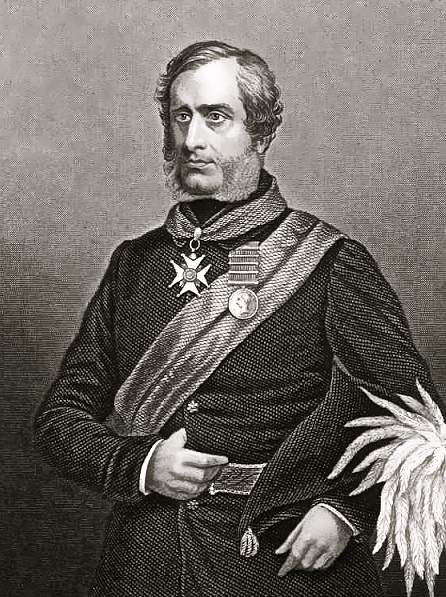
General Henry Havelock |
On the 15th of July, Havelock came in front of the enemy. They had
posted themselves in strength at the village of Aong, with something of
an entrenchment in front, and on either flank some walled gardens,
thickly studded with trees, which afforded serviceable shelter to their
musketeers. But no superiority of numbers or of position could enable
them to sustain the attack of the English. The cost of that morning's
success was indeed heavy, and the day's work was not then over. A few
miles beyond the village of Aong was a river to be crossed, known as the
Pandu Nadi. It was but a streamlet in comparison with the Ganges, into
which it flowed. But the July rains had already rendered it swollen and
turbid, and if the bridge by which it was crossed had been destroyed,
General Havelock's progress would have been most disastrously retarded.
When Havelock's scouts told him that the enemy were rallying, and were
about to blow up the bridge, he roused his men, exhausted as they were.
It was a two hours' march to the bridge-head under a fierce sun. The
enemy, strengthened by reinforcements which had come in fresh from
Cawnpore, under Bala Rao, the brother of the Nana Sahib, were entrenched
on the other side with heavy guns, which raked the bridge. But Maude's
battery was soon brought into action, and a favorable bend of the river
enabling him so to plant his guns as to take the enemy in flank, he
poured such a stream of Shrapnel into them that they were bewildered.
They had undermined the bridgehead, and had hoped to blow the whole
structure into the air before the English could cross the river. But the
Fusiliers, under Major Stephenson, swept across the bridge, and put an
end to all fear of its destruction. Then the rest of Havelock's force
accomplished the passage of the river, and pushed on towards Cawnpore.
They did not then know the worst. The great tragedy of Cawnpore was yet
to come. On the afternoon of that l5th of July, Nana Sahib, learnt that
Havelock's army had crossed the Pandu Nadi, and was in full march upon
his capital. The messenger who brought the evil tidings was Bala Rao
himself, with a wound in his shoulder, as proof that he had done his
best. What now was to be done? The chief advisers of the Nana Sahib were
divided in opinion. They might make a stand at Bithur, or form a
junction with the rebel force at Fathgarh, or go out to meet the enemy
on the road to Cawnpore. The last course, after much discussion, was
adopted, and arrangements were made to dispute Havelock's advance. |
|
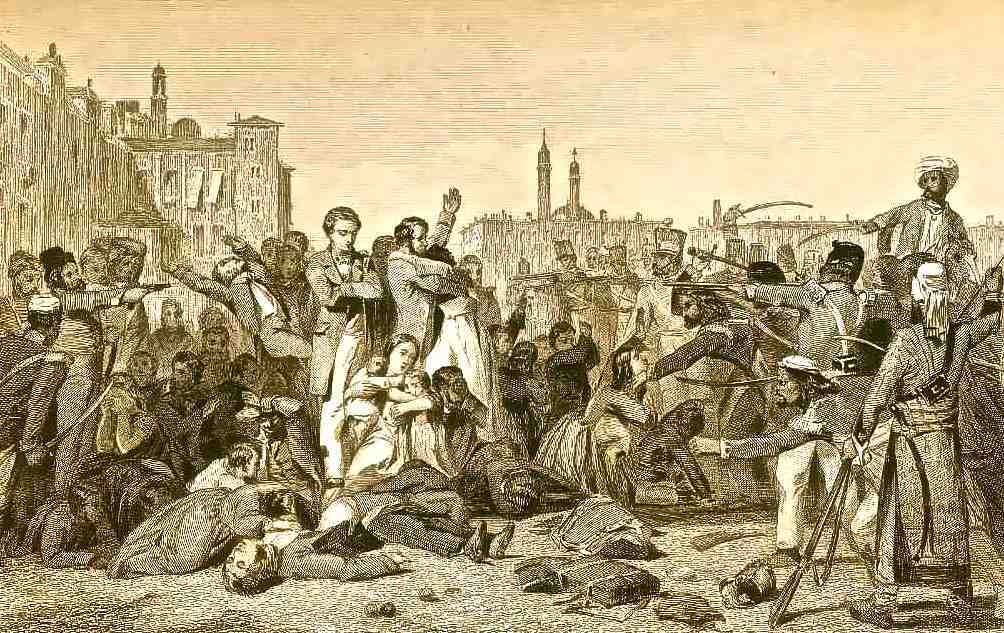
Massacre at Cawnpore - July 15th,
1857 |
| The order went forth for the massacre of the women and children in
the Bibighur. The helpless victims huddled together in those narrow
rooms were to be killed. There were four or five men among the captives.
These were brought forth and killed in the presence of the Nana Sahib.
Then a party of Sepoys was instructed to shoot the women and children
through the doors and windows of their prison house. The task was too
hideous for their performance. They fired at the ceilings of the
chambers. The work of death, therefore, proceeded slowly, if at all. So
some butchers were summoned from the bazaars. They were stout Muslims
accustomed to slaughter, and two or three others, Hindus, from the
villages or from the Nana's guard, were also appointed executioners.
They went in, with swords or long knives, among the women and children,
as among a flock of sheep, and with no more compunction, slashed them to
death with the sharp steel. |
| And there the bodies lay, some only half dead, all through the
night. It was significantly related that the shrieks ceased, but not the
groans. Next morning the dead and the dying were brought out, ghastly
with their still gaping wounds, and thrown into an adjacent well. Some
of the children were alive, almost unhurt, saved doubtless, by their low
stature, amidst the closely-packed masses of human flesh through which
the butchers had drawn their blades, and now they were running about
scared and wonder struck, beside the well. To toss these infantile
enemies, alive or dead, into the improvised cemetery, already nearly
choked-full, was a small matter that concerned but little those who did
the Nana's bidding. None were mutilated, none were dishonored. There was
nothing needed to aggravate the naked horror of the fact that some three
hundred Christian women and children were hacked to death in the course
of a few hours. Then, this feat accomplished, the Nana Sahib and
allies prepared to make their last stand for the defense of Cawnpore and
the Peshwaship. |
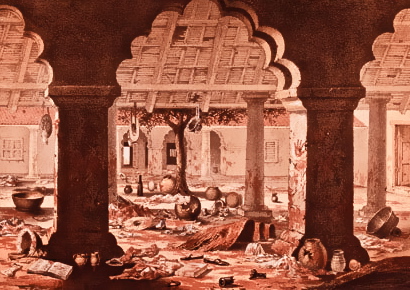 |
| On the morning of July 16th, 1857, Nana Sahib went out himself with
some five thousand men, cavalry, infantry, and artillery to dispute
Havelock's advance. The position, some little distance to the south of
Cawnpore, which he took up was well selected, and all through that July
morning his lieutenants were disposing their troops and planting their
guns.
Meanwhile, General Havelock and his men, unconscious of the great
tragedy that, a few hours before, had been acted out to its close, were
pushing on, under a burning sun, the fiercest that had yet shone upon
their march. The hour of noon had passed before the English General
learnt the true position of the enemy. It was plain that there was some
military skill in the rebel camp, for the troops of the Nana Sahib were
disposed in a manner which taxed all the power of the British Commander,
who had been studying the art of war all his life. To Havelock's column
advancing along the great high road from Allahabad, to the point where
it diverges into two broad thoroughfares, on the right to the Cawnpore
cantonment and on the left, the "Great Trunk," to Dehli, the Sepoy
forces presented a formidable front. It was drawn up in the form of an
arc, bisecting these two roads. Its left, almost resting on the Ganges,
had the advantage of some sloping ground, on which heavy guns were
posted, while its right was strengthened by a walled village with a
great grove of mango-trees, which afforded excellent shelter to the
rebels. Here also heavy guns were posted. And on both sides were large
masses of Infantry, with the 2nd Cavalry in the rear, towards the left
centre, for it was thought that Havelock would advance along the Great
Trunk Road.
Havelock's former victories had been gained mainly by the far
reaching power of the Enfield Rifles and the unerring precision of
Maude's guns. But now he had to summon to his aid those lessons of
warfare, both its rules and its exceptions, which he had been learning
from his youth upwards. The order was given for the advance, and primed
with good libations of malt liquor, they moved forward in column of
subdivisions, the Fusiliers in front, along the high road, until they
reached the point of divergence. Then the Volunteer Cavalry were ordered
to move right on, so as to engage the attention of the enemy and
simulate the advance of the entire force, while the Infantry and the
guns, favored by the well wooded country moved off unseen to the right.
The feint succeeded admirably at first. The Cavalry drew upon themselves
the enemy's fire. But presently an open space between the trees revealed
Havelock's designs, and the Nana's guns opened upon the advancing
columns, raking the Highlanders and 64th, not without disastrous effect.
But nothing shook the steadiness of the advance. The last subdivision
having emerged from the wood, they were rapidly wheeled into line, moved
forward with a resolute front and disconcerted the arrangements on which
the Nana had prided himself so much and so confidently relied. But the
native legions had strong faith in the efficacy of their guns, which
outmatched the English own in number and in weight of metal. |
|
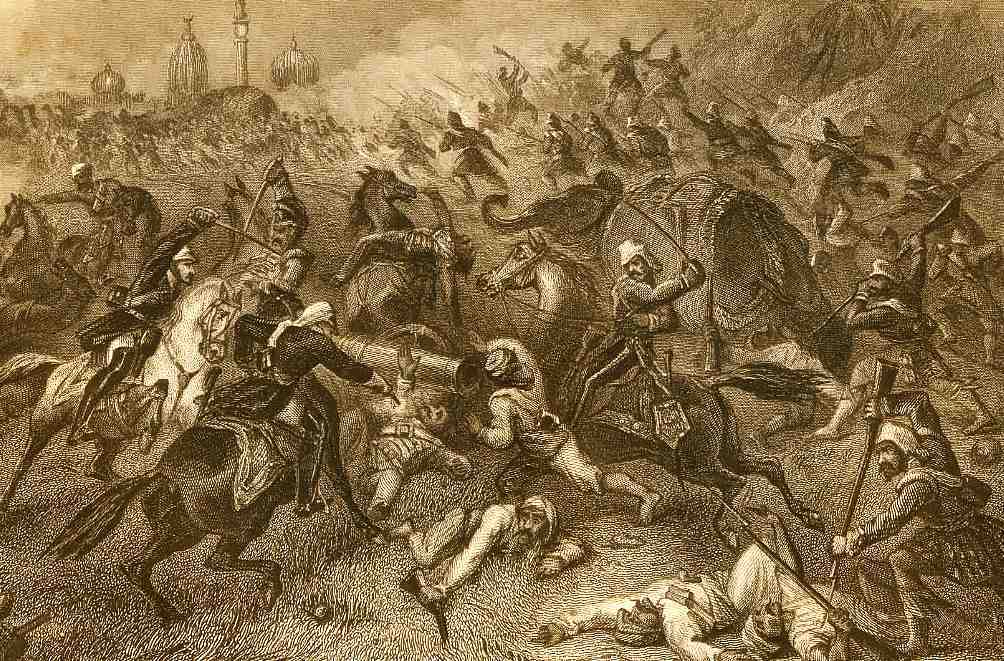
Battle of Cawnpore, India - July
16th, 1857 |
| Maude's battery was struggling through ploughed fields, and his
draft-cattle were sinking exhausted by the way, and even when they came
up, these light field-pieces, could but make slight impression on the
heavy ordnance from the Cawnpore magazine. For a little space therefore,
the Sepoys exulted in the preponderance of their artillery fire, and
between the boomings of the guns were heard the joyous sounds of
military bands, striking up stirring British national tunes, as taught
by English bandmasters, in mockery. The Sepoys selecting those with the
greatest depth of English sentiment in them. |
The awful work of charging heavy guns well served by experienced
gunners, was now to be commenced, and the Highlanders, led by Colonel
Hamilton, were the first to charge. The shrill sounds from the bagpipes
in the rear sent them all forward with a rush, and the kilted soldiers,
with their fixed bayonets, cheered as they went. Strongly posted as the
guns were in a walled village, village and guns were soon carried, and
there was an end to the strength of the enemy's left.
The Sepoy troops fled in confusion, some along the Cawmpore road, others
towards the centre of their position, where a heavy howitzer was posted,
behind which for a while they rallied. The Highlanders, followed by the
64th, flung themselves on the trenchant howitzer and the village which
enclosed it. The gun was captured, and the village was cleared.
Meanwhile, the Infantry swept on to the enemy's right, where two more
guns were posted, and carried them. But the enemy, having found fresh
shelter in a wooded village, rallied with some show of vigor, and poured
a heavy fire into the English line. The Highlanders bounded forward to
take the village. Again the Sepoy host were swept out of their cover,
and seemed to be in full retreat upon Cawnpore, as though the day were
quite lost.
But there was yet one more stand to be made. As gun after gun was
captured by the rush of the British infantry, still it seemed ever more
Sepoy guns were in reserve, to deal out death in the English ranks.
Baffled and beaten as he was, Nana Sahib was resolute to make one more
stand. He had a twenty-four pounder and two smaller guns planted upon
the road to the Cawnpore cantonment, from which fresh troops had come
pouring in to give new strength to the rebel defense. It was the very
crisis of the Peshwa state. Conscious of this, Nana Sahib threw all his
individual energies into the work before him, and tried what personal
encouragement could do to stimulate his troops. He flashed his presence
on his people in a last convulsion of courage and a last effort of
resistance. |
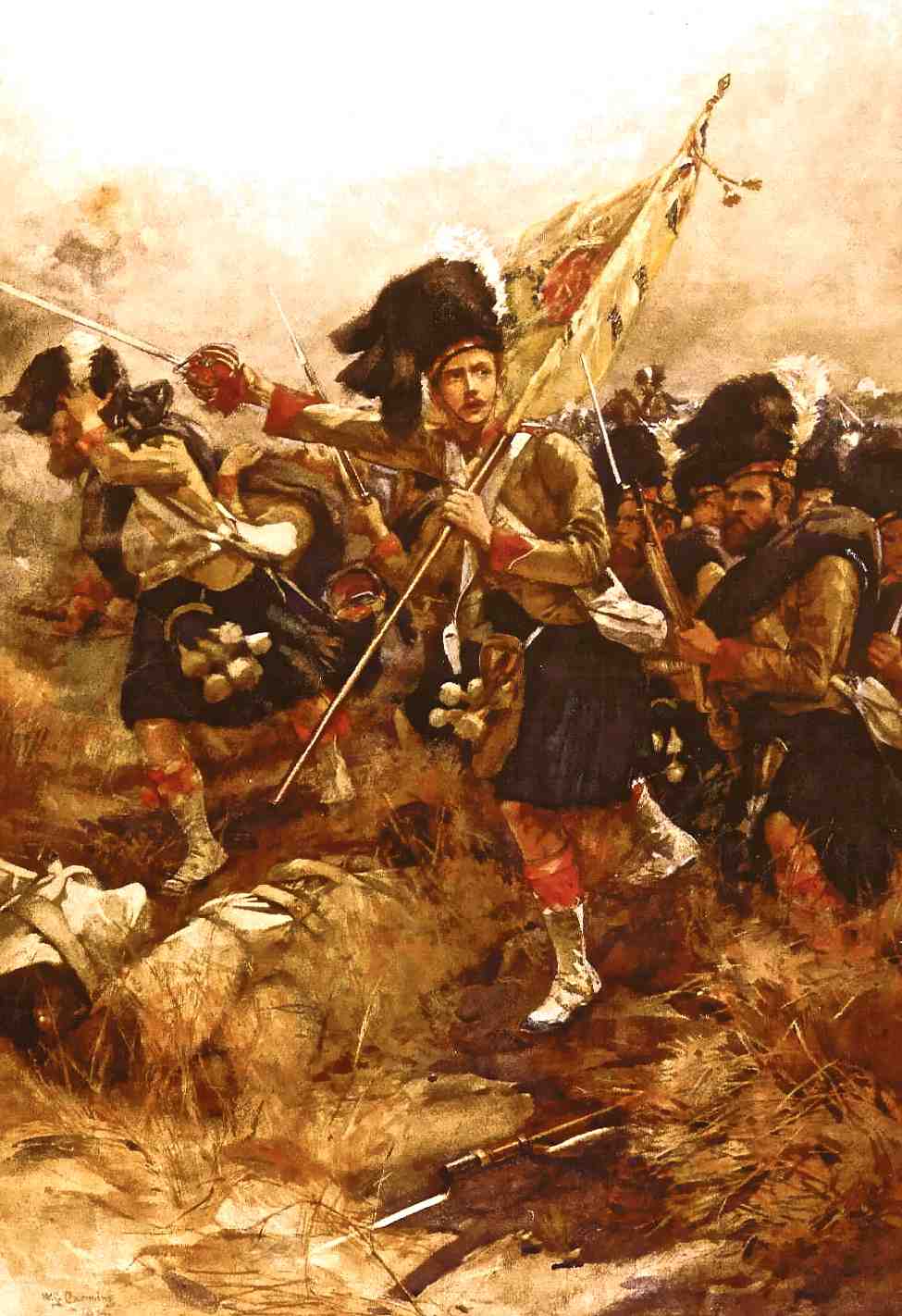
Scottish Highlanders |
The British bivouacked at nightfall two miles from Cawnpore, every
man weary and too thirsty not to relish even a draught of dirty water.
Next morning they marched on to occupy the city. Havelock's spies had
brought in word that the captive women and children, whom they had hoped
to rescue, had been murdered. The morning's news clouded the joy of
yesterday's victory.
The enemy had evacuated the place, leaving behind them only a body of
cavalry to announce the exodus of the rebel force by blowing up the
great magazine, the resources of which had constituted their strength,
and given them six weeks of victory. As the advanced guard neared the
Cawnpore cantonment, there was seen to rise from the earth an immense
balloon-shaped cloud, and presently was heard a terrific explosion,
which seemed to rend the ground beneath one's feet with the force of a
gigantic earthquake. The Mutineers had detonated the magazine!The
once boastful army of the Nana Sahib was broken and dispersed, and none
clearly knew whither it had gone. But those were days in which whole
races were looked upon as enemies, and whole cities were declared to be
guilty and blood-stained.
"Your comrades at Lucknow," said General Havelock in his order of thanks
to his men, “are in peril. Agra is besieged, Dehli is still the focus of
mutiny and rebellion. You must make great sacrifices if you would obtain
great results. Three cities have to be saved, two strong places to be
disblockaded. Your General is confident that he can accomplish all these
things."
Scarcely had the force reached Cawnpore, when drunkenness was upon it.
"Whilst I was winning a victory," said Havelock, "on the 16th, some of
my men were plundering the Commissariat on the line of march. And, once
within reach of the streets and bazaars of Cawnpore, strong drink of all
kinds, the plunder chiefly of our European shops and houses, was to be
had in abundance by all who were pleased to take it."
Large numbers of the Cawnpore population flocked panic stricken out
of the town to hide themselves in the adjacent villages, or to seek
safety on the Oude side of the river. Meanwhile, the British forces were
plundering in all directions, the Sikhs, as ever, showing an activity of
zeal in this their favorite pursuit. General Havelock set his face
steadfastly against it, and issued an order in which he said, "The
marauding in this camp exceeds the disorders which supervened on the
short-lived triumph of the miscreant Nana Sahib.” |
|
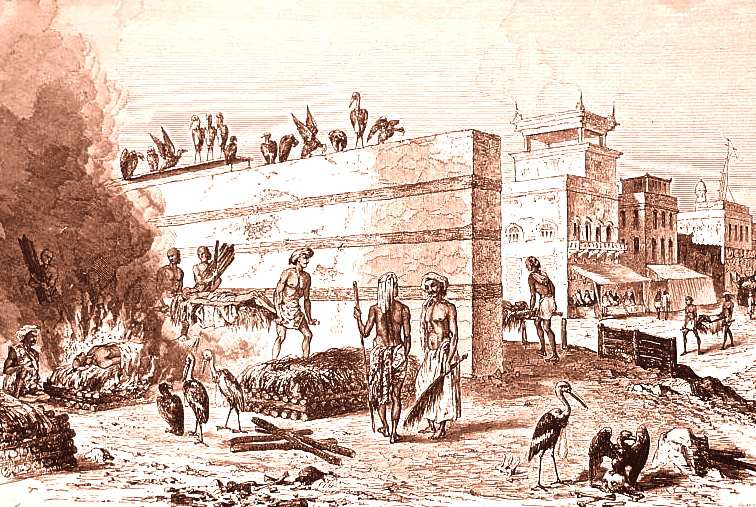 |
After the battle, the baffled Maratha had taken flight to Bithur,
attended by a few Sawars. On his journey, as he rode through Cawnpore, his horse no
doubt flecked with foam, criers were proclaiming that the English had
been well-nigh exterminated, and offered rewards for the heads of the few
who were still left upon the face of the earth. But the lie had
exploded, and his one thought at that moment was escape from the
pursuing Englishman. Arrived at Bithur, he saw clearly that the game was
up. His followers were fast deserting him. Many, it is said, reproached
him for his failure. All, we may be sure, clamored for pay. His
terror stricken imagination pictured a vast avenging army on his track
no doubt,
and the great instinct of self-preservation prompted him to gather up
the women of his family and embark by night on a boat, to ascend the
Ganges to Fathgarh, and to give out that he was preparing himself for
self-immolation.
He was to consign himself to the sacred waters of the Ganges, which had
been the grave of so many of his victims. There was to be a given
signal, through the darkness of the early night, which was to mark the
moment of the ex-Peshwa's suicidal immersion. But he had no thought of
dying. The signal light was extinguished, and a cry arose from the
religious mendicants who were assembled on the Cawnpore bank of the
river, and who believed that the Nana Sahib was dead. But, covered by
the darkness, he emerged upon the Oudh side of the Ganges, and his
escape was safely accomplished.After General Havelock captured
Cawnpore by defeating Nana Sahib in the hotly contested battle on June
16, 1857, Tantya Tope, the able General of Nana Sahib, was successful in
winning over the troops at Shivajinagar and Morar. With the concerted
strength of these troops Nana Sahib and Tantya Tope recaptured Cawnpore
in November 1857. But they could not keep Cawnpore under their charge
for long because the English General Campbell appeared there with a
large force. The British won a decisive victory against the forces of
Nana Sahib in the battle which was fought from
December 1st to the 6th, 1857. Nana Sahib fled towards Nepal,
where he probably died, while Tantya Tope migrated to Kalpi. |
|
 |
|
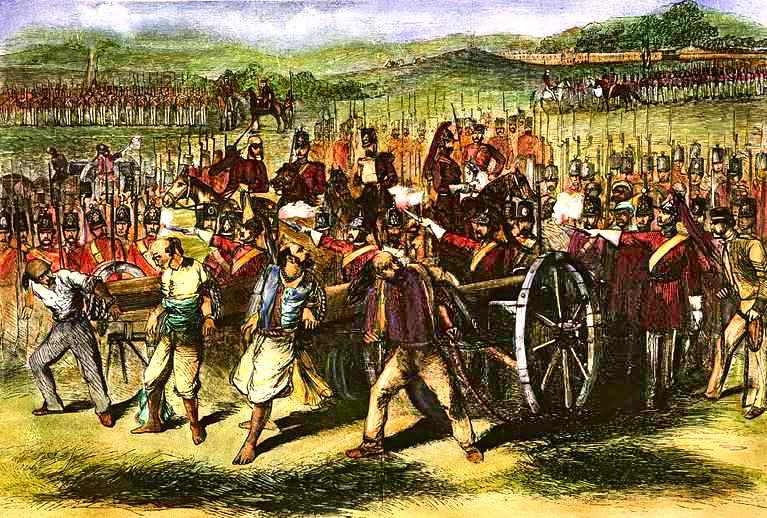 |
| "I am not exaggerating," wrote one officer, "when I tell you that
the soles of my boots were more than covered with the blood of these
poor wretched creatures. Blood-stained clothing was scattered about, as
well as leaves ripped out of the Bible and out of another appropriately
titled book, Preparation for Death." On finding the scenes of murder,
and inflamed with anger, the English extracted revenge. Most of the
perpetrators had made good their escape, but the British made
captured Indians, whether involved or not, lick the blood stains of the
dead. Hindus were forced into eating beef, Muslims pork. The latter were
tied up in pigskin before being executed. Many inhabitants of Cawnpore
who had played no part in the violence were summarily executed for
having failed to do anything to prevent the killings. The preferred
method of execution was to blow the perpetrator from the guns as hanging
seemed to easy a death. The victim was tied to the muzzle of an
artillery gun and blown to pieces. Retribution had been brutal.
Where the woman and children were mercilessly killed, the British left
the room untouched, and filled in the
well of the house only partially, so that they could stand as
terrible reminders to new troops from England that their duty must be
sustained by a desire for revenge. One soldier, his head full of tales
of atrocities, reported: "I seed two Moors [Indians] talking in a cart.
Presently I heard one of 'em say 'Cawnpore.' I knowed what that meant;
so I fetched Tom Walker, and he heard 'em say 'Cawnpore,' and he knowed
what that meant. So we polished 'em both off."
The house in which they were butchered, and which is stained with
their blood, would not be washed or cleaned by their English countrymen,
but Brigadier-General Neill had determined that every stain of
that innocent blood shall be cleared up and wiped out, previous to their
execution, by such of the miscreants as may be hereafter apprehended,
who took an active part in the mutiny, to be selected according to their
rank, caste, and degree of guilt. Each miscreant, after sentence of
death is pronounced upon him, will be taken down to the house in
question, under a guard, and will be forced into cleaning up a small
portion of the blood-stains, the task will be made as revolting to his
feelings as possible, and the Provost Marshal will use the lash in
forcing any one objecting to complete his task. After properly clearing
up his portion, the culprit is to be immediately hanged, and for this
purpose a gallows will be erected close at hand!
The first culprit was a Subahdar of the 6th Native Infantry, a very high
Brahman. The sweeper's brush was put into his hands by a sweeper, and he
was ordered to set to work. He had about half a square foot to clean. He
made some objection, when down came the lash, and he yelled again. He
wiped it all up clean, and was then hung, and his remains buried in the
public road. Some days after, others were brought in. One a Muhammadan
officer of the civil court, a great rascal, and one of the leading men.
He rather objected, was flogged, made to lick part of the blood with his
tongue.
It was contended that, as there were different degrees of murder, there
should also be different degrees of death punishment. Colonel John
Nicholson, was eager to have a special Act passed, legalizing in
certain cases more cruel forms of execution, that is to say, death with
torture. "Let us," he wrote to Colonel Edwardes, at the end of May 1857,
"propose a Bill for the flaying alive, impalement, or burning of the
murderers of the women and children at Dehli. The idea of simply hanging
the perpetrators of such atrocities is maddening. I wish that I were in
that part of the world, that if necessary I might take the law into my
own hands."
Again, a few days later, vehemently urging this exceptional legislation:
“You do not answer me about the Bill for a new kind of death for the
murderers and dishonorers of our women. I will propose it alone if you
will not help me. I will not, if I can help it, see fiends of that stamp
let off with simple hanging." Edwardes, it seems, was naturally
reluctant to argue the question with his energetic friend, but Nicholson
could not rid himself of the thought that such acts of cruel retribution
were justified in every sense, and he appealed to Holy Writ in support
of the logical arguments which he adduced. Writing at a later period, he
said, "As regards torturing the murderers of the women and children; If
it be right otherwise, I do not think we should refrain from it, because
it is a Native custom. We are told in the Bible that stripes shall be
meted out according to faults, and, if hanging is sufficient
punishment for such wretches, it is too severe for ordinary mutineers.
If I had them in my power to-day, and knew that I were to die to-morrow,
I would inflict the most excruciating tortures I could think of on them
with a perfectly easy conscience. Our English nature appears to be
always in extremes. A few years ago men (frequently innocent) used to be
tortured merely on suspicion. Now there is no punishment worse than
hanging, which is a very easy death, for atrocities which could not be
exceeded by fiends.”
“It is necessary in all Eastern lands to establish a fear and awe of the
Government. Then, and not till then, are its benefits appreciated.
Previously, they are ascribed to weakness. We must be sternly,
rigorously just against all treason, violence, and treachery, and hand
down a tradition of our severity. Otherwise these troubles will recur."
|
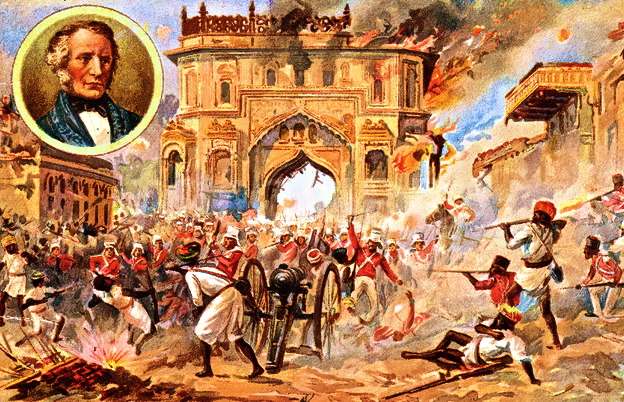 |
 |
|
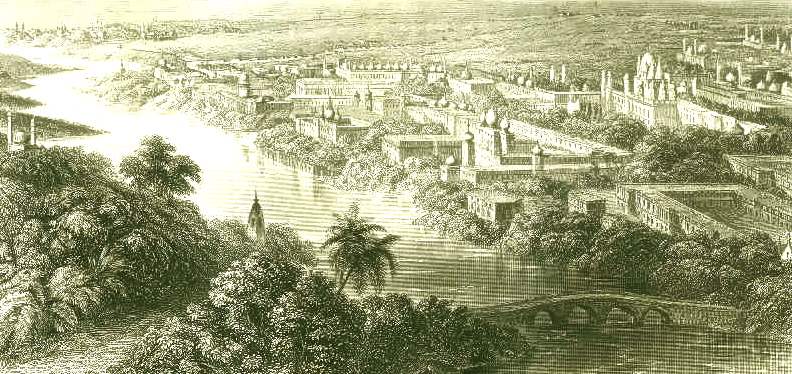
Lucknow, India - 1857 |
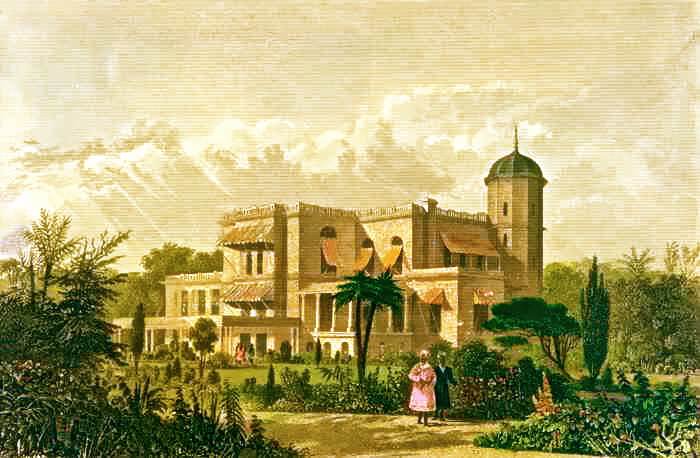
British Residency - Lucknow . . 1857 |
Lucknow, 1857, on the banks of the River Gomti, was the capital of
Oudh. The State of Oudh was annexed the year before in a move which
caused great resentment amongst the Indians. Lucknow itself was full of
the hangers-on of the old regime who were eager to reverse their recent
dispossession.
In Lucknow, the population as well as the army was in revolt. The war
against the British was led by the Begum of Awadh Hazrat Mehal who
proclaimed her young son Nawab. Hazrat Begum felicitated her troops in
person.
All the British residents were besieged in the Residency area. There,
600 women and children and 680 other non-combatants were defended by
1,760 men.
The operations at the siege of Lucknow, from May 1857 to March 1858
involved, in succession, the defense of the residency, the reinforcement
of the garrison, the relief and the withdrawal of women and children,
and the siege and capture of the city. |
|
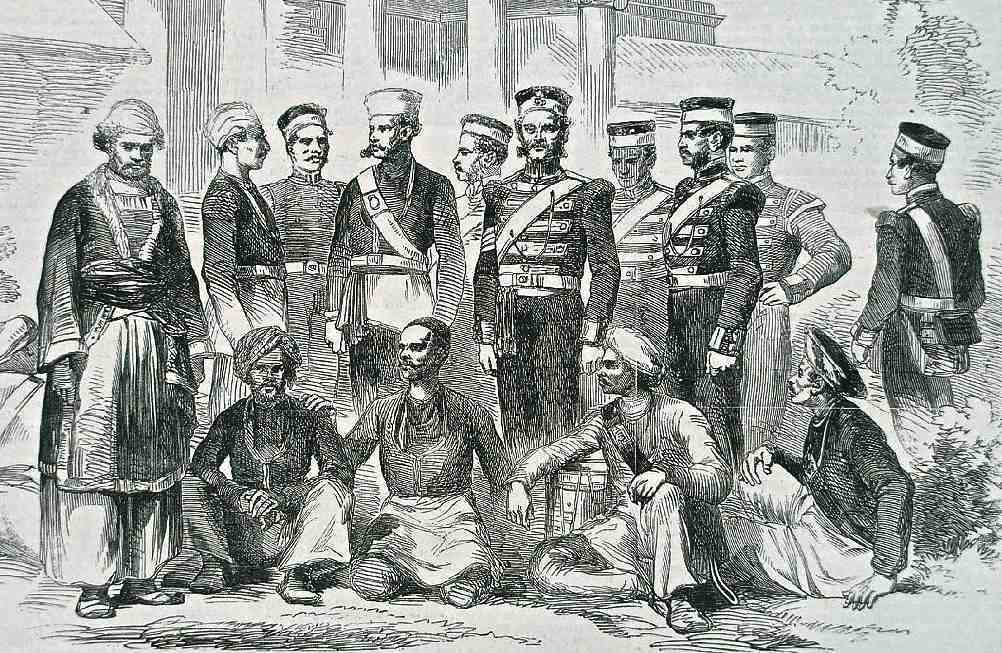
Sepoys at Lucknow |
| On the evening of the 30th of May, 1857, the revolt broke
out. It began in the lines of the Seventy-first and spread at once to
the other native regiments, who took up arms, fired the bungalows, and
killed all the officers upon whom they could lay hands. The tide of
revolution touched its highest mark in Oudh. Not only the Hindu and
Muslim Taluqdars, but even the common people went all out to help the
dispossessed Nawab, Wajid Ali Shah. As soon as the revolt broke out the
people carried out a massacre of the English. Sir Henry Lawrence,
the Chief Commissioner of Oudh, knew the dangers of the British position
in Lucknow, and when mutiny swept through Oudh not long after the events
at Meerut, he was reasonably well prepared. He decided to make his stand
inside the Residency compound and he fortified it strongly. All the
European residents in Lucknow were called into the lines of the
Residency. The small European force being then divided between that post
and the Mutchee Bawn, a strong fort three-quarters of a mile distant.
The Residency, a 33 acre refuge, had a garrison of about 1,700 men. Half the defending force were Sepoys
who had remained loyal to the British. Inside the Residency compound
there were nine separate buildings and a high mud-wall strengthened by
earthworks formed the perimeter. Lawrence had prepared the position as
much as possible. Trenches and gun pits had been dug, wire-entanglements
laid out and booby traps set.
Unfortunately, the Residency was almost in the centre of the city. On
its eastern side stood the old palace of the kings of Oudh. To the north
flowed the river. All round, however, were the narrow streets and lanes
of the old city sometimes coming up to the very walls of the compound
itself.
|
The Mutineers began attacking the Residency on July 4th, 1857.
Lawrence was killed almost immediately. The enemy opened fire from
several batteries. A shell penetrated the small room in the Residency in
which Sir Henry Lawrence was sitting, and passed between him and his
private secretary, Mr. Cowper. His officers begged him to change his
room, but he declined to do so, saying laughingly that the room was so
small that there was no chance of another shell finding its way in. He
was, however, mistaken, for the very next day a shell entered, and burst
in the room. His body was nearly cut in two. The main problem was always
the constant barrage of artillery and musket fire that the mutineers
were able to pour into the compound.
During the first week they lost twenty a day shot in the houses, but
then, as far as possible, they blocked every loophole at which a bullet
can enter. They were then not losing so many as at first, but the daily
total was still heavy, and on one day they lost thirty. The enemy
attacked all round, and they mowed them down with grape. They killed
over a thousand of them, but every day their losses were getting heavier
from disease, foul air, and over-crowding.
Day after day the fighting had continued, the enemy ever gaining in
numbers and in strength, erecting fresh batteries, and keeping up a
ceaseless fire night and day upon the garrison. The Sepoys tried to
storm the walls but were always beaten back. Sometimes, they breached
the perimeter and British sallies to regain lost ground or eliminate
strong points near the walls became necessary and commonplace. The
Sepoys laid siege, and assaults were launched almost daily for the next
three months. |
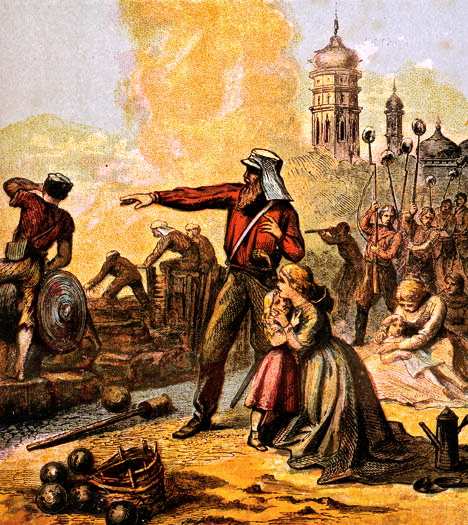 |
Heralded by a storm of fire from every gun which could be brought to
bear upon the battery, thousands of fanatics rushed from the shelter of
the houses outside the entrenchments and swarmed down upon it. The
garrison lay quiet behind the parapet until the approach of the foe
caused the enemy's cannon to cease their fire. Then they leaped to their
feet and poured a volley into the mass. So great were their numbers,
however, that the gaps were closed in a moment, and with yells and
shouts the enemy leaped into the ditch and tried to climb the earthworks
of the battery. At this moment, the reserve of fifty men of the
Thirty-second, which were always kept ready to launch at any threatened
point, came up at a run, and their volley over the parapet staggered the
foe. Desperately the leaders called upon them to climb the earthworks,
but the few who succeeded in doing so were bayoneted and thrown back
into the ditch, while a continuous musketry fire was poured into the
crowd. Over and over again the guns, charged with grape, swept lines
through their ranks, and at last, dispirited and beaten, they fell back
again to the shelter from which they had emerged.
A further misery was soon added to the sniping, the shelling and the
direct assaults on the perimeter - the Sepoys began tunneling. Trying to
undermine the walls, the charges the Sepoys detonated sometimes exploded
well inside the compound. The British were forced to counter-mine and
some of the fiercest battles of the siege were fought deep in the hot
clammy earth with pistols, shovels and fists.
"To arms! They hare fired a mine under the Sika Square!" Every man
caught up his rifle and rushed to the spot. The mine had carried away a
portion of the exterior defense, and the enemy, with yells of triumph,
rushed forward toward the opening. Then ensued a furious melee; each man
fought for himself, hand to hand in the breach. Mussulman and Englishmen
struggled in deadly combat; the crack of the revolver, the thud of the
clubbed guns, the clash of sword against steel, the British cheer and
the native yell, were mingled in wild confusion. While some drove the
enemy back, others brought boxes and beams, fascines and sandbags, to
repair the breach. The enemy were forced back.
Lucknow was always celebrated for its plague of flies, but during the
siege the nuisance assumed fantastic proportions. The number of cattle
and animals collected, the blood spilt in the slaughter yard, the
impossibility of preserving the cleanliness so necessary in a hot
climate, all combined to generate swarms of insidious flies. |
|
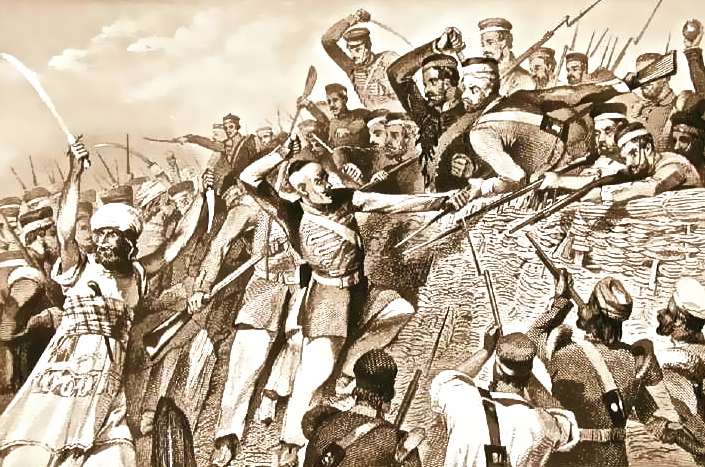 |
The month of August 1857 began badly in Lucknow. Major Banks,
the civil commissioner named by Sir Henry Lawrence to succeed him, was
shot dead while reconnoitering from the top of an outhouse.
On the 8th large bodies of Sepoys were observed to enter the city, and
on the 10th a furious attack was made all round the British line. Every
man capable of bearing arms stood at his post, and even the sick and
wounded crawled out of hospital and took posts on housetops wherever
they eould fire on the foe. The din was prodigious—the yells of the
enemy, their tremendous lira of musketry, the incessant roar of their
cannon
Frequently large bodies of men showed from behind their shelter, and
carrying ladders, advanced as if with the determination of making an
assault. Each time, however, the withering fire opened upon them from
the line of earthworks, from the roof of every house, and the storm of
grape from the batteries caused them to waver and fail back. Each fresh
effort was led by brave men, fanatics, who advanced alone far in front
of the rest, shrieking, "Death to the infidel!"
Food started to run short, the casualties started to mount, rats swarmed
everywhere, and the July sun burned down on the now filthy, hungry and
dispirited defenders. In the middle of August, a message finally reached Lucknow
that told of a relief force beginning its march. Four days, the note
promised, would see an end to their troubles. Welcome news indeed as the
garrison had been reduced to 350 British soldiers and 300 loyal Sepoys,
with over 550 women, children, sick and wounded to look after. The four
days came and went with no sign of any assistance. The days became weeks
and still no-one came.
Crowded in dark rooms, living on the most meager food—for all the
comforts, such as tea, sugar, wine, spirits, etc., were exhausted, and
even the bread was made of flour ground, each for himself, between rough
stones—without proper medicines, attendance, or even bedding ; tormented
by a plague of flies, sickened by disgusting smells, condemned to
inaction and confinement, the women and children died off rapidly, and
the men, although better off with regard to light and air, were under
tremendous stress. Half the officers were laid up with disease, and all
were lowered in health and strength. |
|
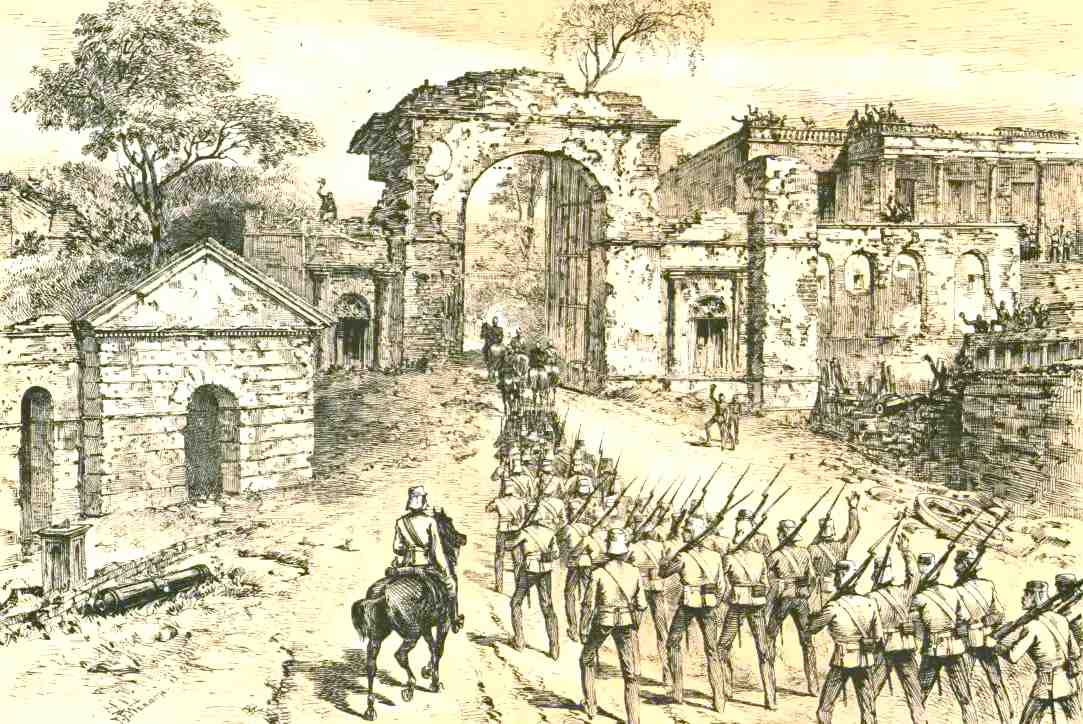
Lucknow Relief Column - September 25th, 1857 |
|
In India it is the universal custom to start very early,
so as to get the greater part of the march over before the heat of the
day fairly begins
|
| At the end of the September month, a relief force of some 3,000 men
under Generals Sir Henry Havelock and Sir James Outram broke through
mutineer lines and reinforced the garrison. Unfortunately, the British
were not numerous enough to break out of Lucknow, and the new arrivals
put a heavy strain on the garrison food supply. |

The sick and wounded, heavy baggage, and large supply train were left at
Alambagh, protected by a guard of three hundred men drawn from all units
in the force.
On the 25th of September the advance from Alambagh began. General
Neill's Brigade was in the lead and the 78th Highlanders and Ferozepore
Regiment were detailed as rearguard and ordered to hold the bridge at
Charbagh until everything had passed. The Madras Fusiliers, with the
84th Foot, forced the bridge and Havelock then led his force round east
of the city. This move evidently surprised the rebels, for he met no
serious opposition until he arrived a short distance from the Residency.
Meanwhile, the Highlanders and Sikhs were heavily engaged at Charbagh,
where they were attacked by a large force of rebels. After three hours'
fighting they defeated the enemy and were able to push on. However, they
had lost touch with the main British column and took the wrong road.
This mistake proved most fortunate, for they suddenly encountered the
rear of some guns which were holding up Havelock's advance and rushed
them without ceremony. The 78th Highlanders and Ferozepore Regiment were
now in front. The Residency was only some five hundred yards away, but
since it was now dusk and the column was strung out over a considerable
distance General Outram suggested halting. General Havelock, however,
was determined to reach the Residency without delay and ordered the 78th
Highlanders and Brasyer's Sikhs to advance. |
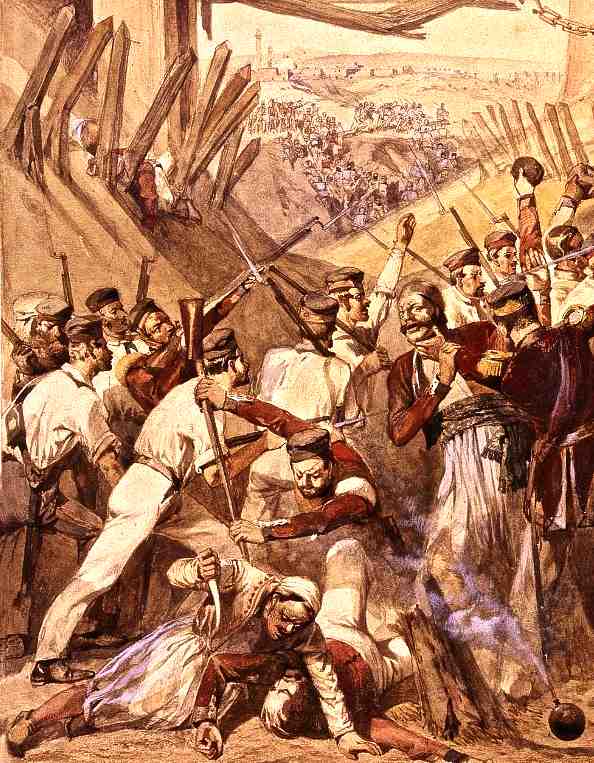 |
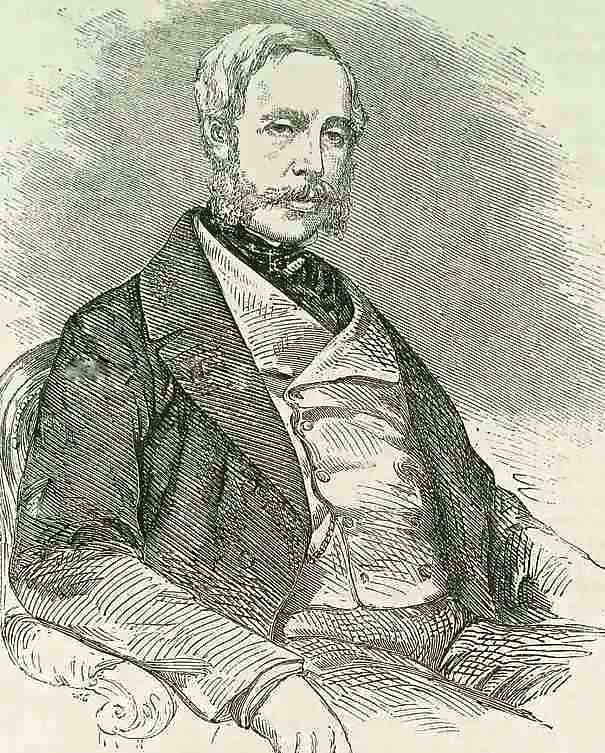
General
James Neill |
They advanced into a fire that seemed, as General Havelock said, as
if nothing could live under it. The Highlanders, being Europeans, were
placed in front, but the Sikhs followed them closely. General Neill fell
mortally wounded. They dashed forward through the narrow streets of
flat-roofed, loop-holed houses held by the Mutineers. The Highlanders
and Sikhs fought their way forward desperately under continuous fire
from the enemy. The troops were jumping over cuttings and other
obstacles in the street, until they finally reached the Bailey Guard
Gate of the Residency. But this was not only shut, but barricaded. The
enemy were firing from the roofs and windows of houses in every
direction. Finally, a breach was opened and the reinforcements swarmed
inside the Residency.
During the day's desperate fighting many acts of heroism were performed
as the Regiment suffered a very large proportion of casualties. One
noteworthy feat of gallantry was that of Sepoy Nihal Singh, of the
Ferozepore Sikhs, who carried General Neill, when he was mortally
wounded in the final charge, to the rear under heavy fire.The rearguard, with a number of sick and wounded, had not been able
to reach the Residency and had remained in the Moti Mahal. So, on the
next day, a detachment of the 5th Fusiliers and Brasyer's Sikhs was sent
to reinforce them and help them to withdraw to the Residency. Although
the Sikhs and Fusiliers fought their way through and drove the enemy
back from the buildings and gardens adjacent to the Mod Mahal, the enemy
fire from the Kaiserbagh was found to be too heavy to admit of the
rearguard convoy being moved back. Further reinforcements from the 78th
Highlanders were then sent forward and the rearguard was safely
withdrawn to the Residency after dark. |
| After arriving in the Residency area Sir James Outram took over, from
General Havelock, the command of the British forces. Although the rebels
had been outwitted, they had not been decisively defeated and still
occupied the city in great strength. It was found to be quite
impracticable to carry out the original intention of withdrawing the
besieged people in the Residency and all the relieving force could do
was to aid its defenses. There were now 3,000 additional troops, so
there was no longer an imminent danger of the garrison being
overwhelmed. However, the Residency was besieged as closely as ever, and
Sir James Outram had to stand on the defensive and await relief in his
turn. With the increased number of troops in the Residency positions
had to be enlarged and so for the next few days several sorties were
made to improve the position. The Regiment of Ferozepore was in General
Havelock's sector and took part in the sorties along the eastern face of
the Residency to clear the enemy from the gardens and houses up to the
Chattar Manzil. These sorties were entirely successful and improved the
defenses of the Residency. |
|
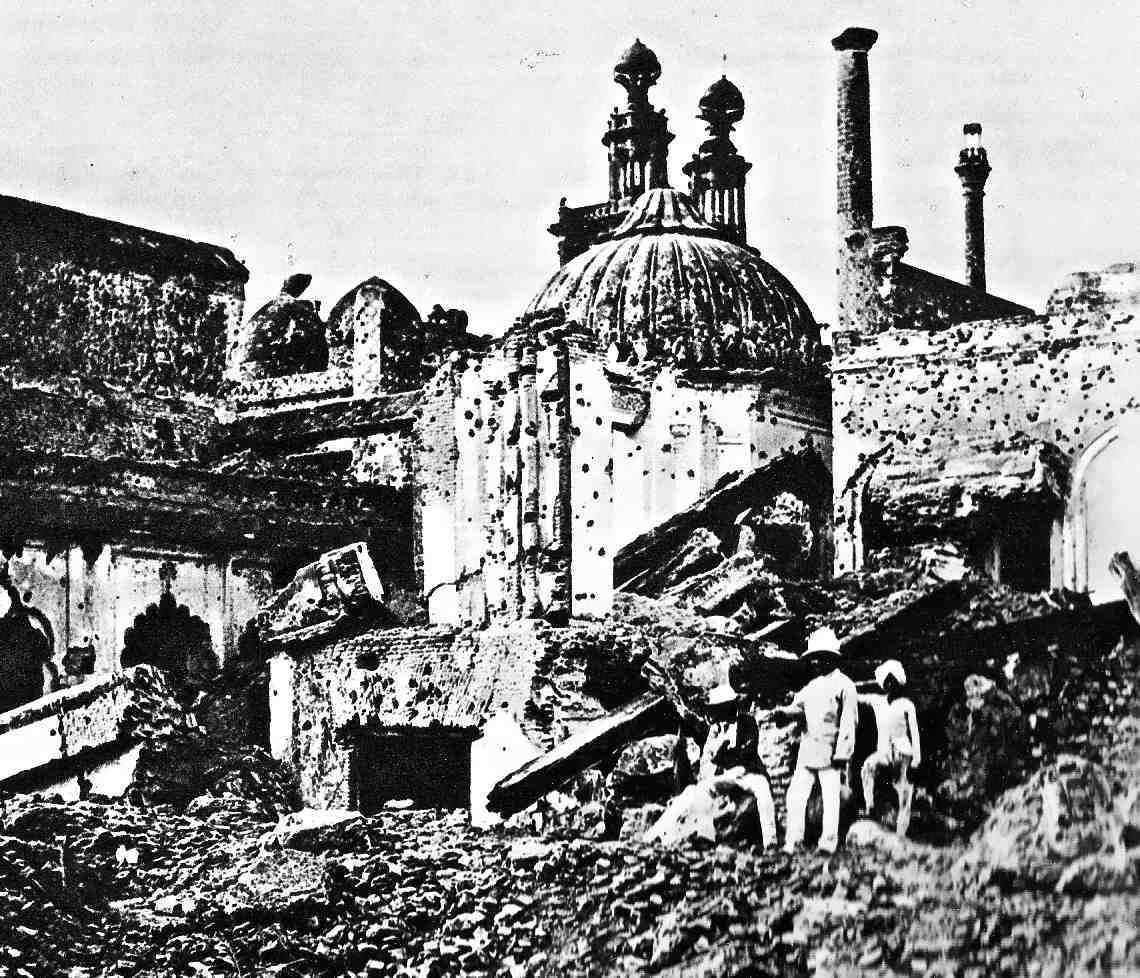
Siege of Lucknow - Chattar Manzil
Palace . . 1857
A magnificent three storied structure with an elegant
façade and a fine dome, surmounted by a gilt umbrella, which gives it
its name, Chattar Manzil. Overlooking the river, its fabulous
furnishings and lofty halls made it a premier palace. There are huge tah
khanas or cellars, and secret tunnels. The palaces were strongholds for
Indian rebels during the uprising of 1857, and the British valued their
capture.
At the approach of Sir Henry Havelock with 3,000 troops on September
25th, 1857, a large mine beneath the outer wall of the Chattar Manzil
Palace, occupied by part of the British garrison, was exploded by the
mutineers. The high wall of the Chattar Manzil was later destroyed in
November of 1857, and the British opened heavy batteries upon the
Indians, before storming and capturing it. |
|
For the next two
months, October and November, 1857, Brasyer's Sikhs were put in charge
of the Bailey guard, one of the most important positions in the
Residency, and they also held the defenses on the right of General
Havelock's sector bordering the Pyne Bagh. Outram's force was given no
rest by the enemy and it had always to be on the alert. Duties were
constant and arduous, while rations were scanty throughout the siege. On
one occasion, when the enemy blew a breach in the defences, a detachment
of the Ferozepore Sikhs checked a large force of the enemy who stormed
the breach, and gave the garrison time to form and repulse the enemy.
Jemadar Gowahir Shah was in command of the guard and was awarded the
Indian Order of Merit for his gallant conduct. |
At last, on the November 14th, 1857, a relieving force under General
Sir Colin Campbell, Commander-in-Chief in India, arrived at Lucknow.
Several locations on the outskirts of Lucknow were attacked and
taken. An enemy counter attack was defeated.
Sir Colin Campbell determined that, instead of forcing his way through
the narrow streets as General Havelock had done, he would move partly
round the town, and attack by the eastern side, where there was much
open ground, sprinkled with palaces and mosques and other large
buildings. These could be attacked and taken one by one.
November 16th, 1857, is a date in the annals of British military
history upon which some of the fiercest and bloodiest fighting which
ever took place in India occurred. The Sikander Bagh was held by
mutinous Sepoys of the 71st British Native Infantry and Oudh Irregulars.
Beyond the canal stood the Sikander Bagh (Alexander's Garden), a
building of strong masonry, standing in a garden surrounded by a very
high and strong wall. This wall was loop-holed for musketry. The gate,
which led through a fortified gateway, had been blocked with great piles
of stones behind it, and a very strong garrison held it. In front, a
hundred yards distant, was a fortified village, also held in great
force. Separated from the garden of the Sikander Bagh only by the road
was the mosque of Shah Nujeeff. This building was also situated in a
garden with a strong loop-holed wall, and was lined with the insurgent
troops; while the terraced roof of the mosque, and the four minarets
which rose at its corners, were crowded with riflemen.
The column of attack was commanded by Brigadier Hope, and as it crossed
the bridge of the canal and advanced, a tremendous musketry fire was
opened upon it from the village which formed the advance post of the
enemy. The column broke up into skirmishing line and advanced steadily.
"The guns to the front!" came the command to the naval brigade. |
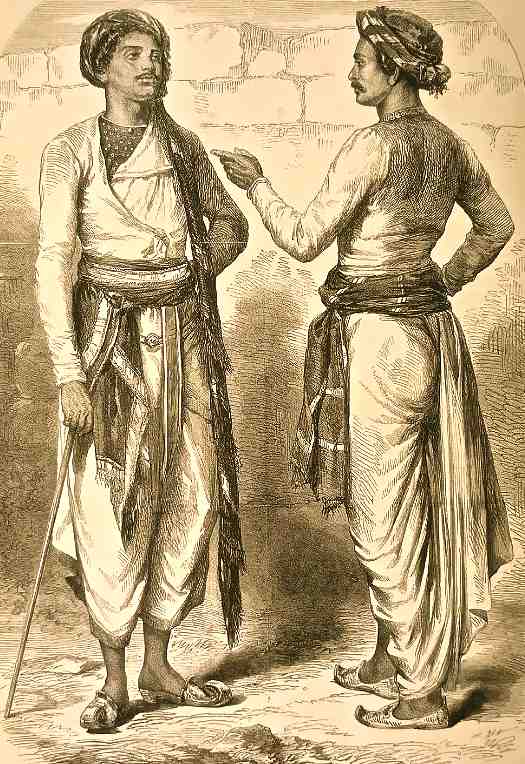
Bengal Sepoys |
|
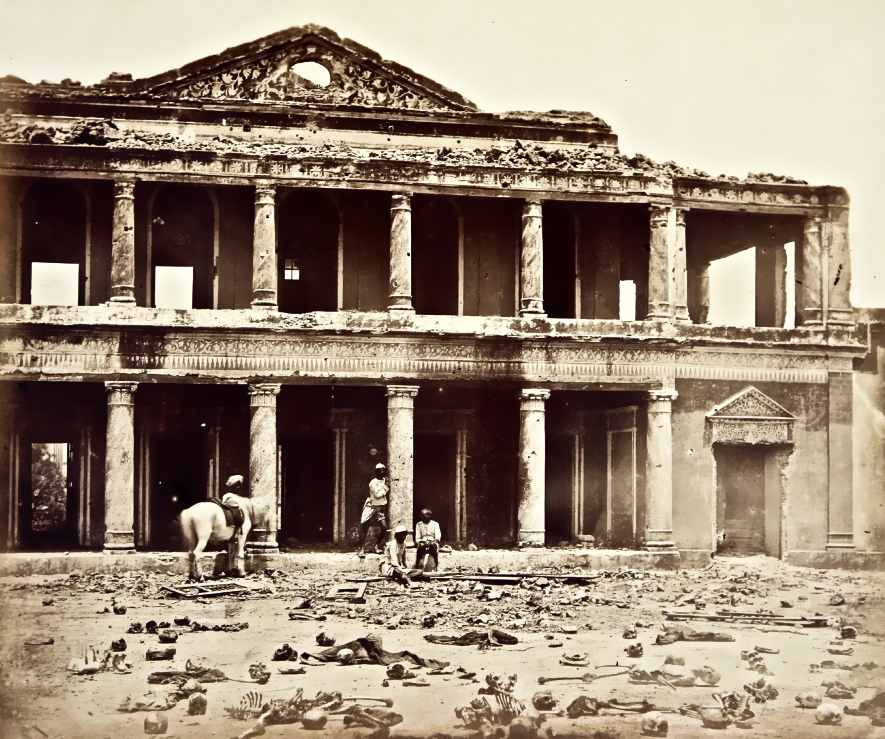
The Sikander Bagh in Lucknow was the venue for a
fierce battle during the 1857 uprising. This picture, taken by Felice
Beato, an Italian who visited India soon after the mutiny and, some say,
had the bones dug out for this photo, is possibly the first photographic
depiction of human corpses |
The Sikandar Garden is a villa and garden complex
located on the outskirts of Lucknow, which was the capital of the former
state of Oudh (now spelt Awadh, and a region in the state of Uttar
Pradesh), in India. The prolonged defense in Lucknow by the British
proved to be one of the key episodes in the unsuccessful Indian
Rebellion of 1857-1858. During the siege of the city, the Sikandar (or
Secundra) Garden was used as a refuge by hundreds of Sepoys who were
under attack by British troops.
On November 16th, 1857, the villa was overrun during the second relief
of Lucknow, by General Sir Colin Campbell. The Sikander Bagh, a walled
enclosure of strong masonry, held by a large body of rebels, barred the
way to the Residency. After a bombardment of about an hour and a half,
it was taken by storm by the 93rd Highlanders and the 4th Punjabis, with
very heavy loss to the enemy. Campbell’s men had learned of the massacre
at Cawnpore where over 200 British women and children had been butchered
by Mutineers. Enraged by this, they showed no mercy to the Secundra
Bagh’s over 2,000 defenders, slaughtering all. After the fighting, the
British dead were buried in a deep trench but the Indian dead were left
to rot. |
|
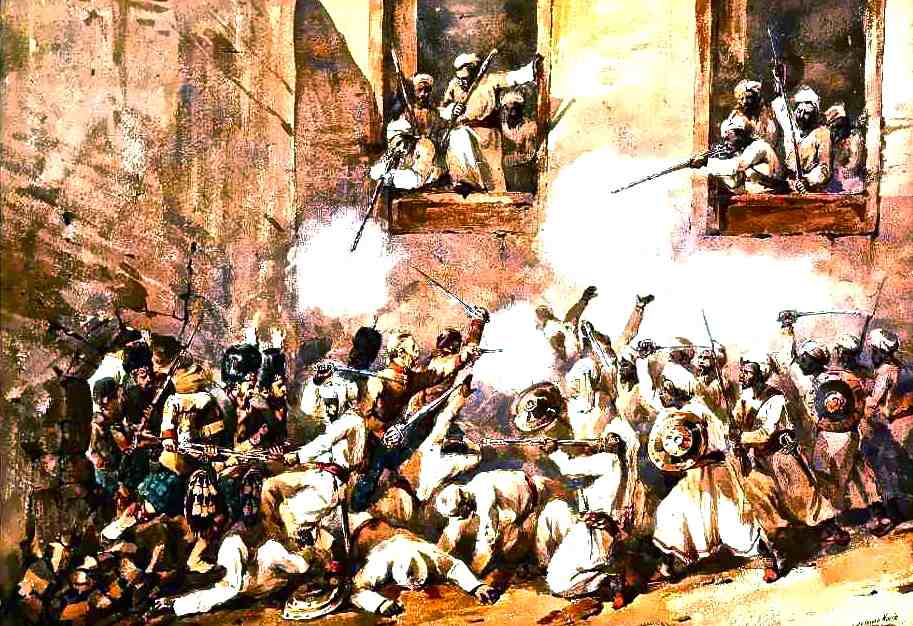
Lucknow - Storming Sikander Bagh |
It took somewhat longer to bring the ponderous sixty-eight pounders
of the naval brigade into action, but their deep roar when once at work
astonished the enemy, who had never before heard guns of such heavy
metal.
The guns were now brought forward, and their fire directed at the strong
wall. The heavy cannon soon made a breach, and the assault was ordered.
The Fourth Sikhs had been directed to lead the attack, while the
Ninety-third Highlanders and detachments from the Fifty-third and other
regiments were to cover their advance, by their musketry fire at the
loopholes and other points from which the enemy were firing.
Then ensued a frightful struggle; two thousand Sepoys held the garden,
and these, caught like rats in a trap, fought with the energy of
despair. Nothing, however, could withstand the troops, mad with the
long-balked thirst for vengeance, and attacked with the cry—which in
very truth was the death-knell of the enemy—"Remember Cawnpore!" on
their lips. No quarter was asked or given. It was a stubborn, furious,
desperate strife, man to man—desperate Sepoy against furious Englishman.
But in such a strife weight and power tell their tale, and not one of
the two thousand men who formed the garrison escaped : two thousand dead
bodies were next day counted within the four walls of the garden. Later
that afternoon the Shah Najaf was captured with heavy losses on both
sides. |
|
On the day of the arrival of the British at Dil I'loosha,
signals from the towers of that palace had established communication
with the Residency, and it was arranged that as soon as the relieving
forces obtained possession of the Sikander Bagh the troops of the
garrison should begin to fight their way to join them.
Delighted at taking the offensive after their long
siege, Havelock's troops on the 16th attacked the enemy with fury, and
carried two strong buildings. First, the Hero Khana and then dashed on
through the Chattar Manzil, and carried all before them at the point of
the bayonet.
It soon became apparent, however, that the enemy had no
intention of deserting their stronghold. Lucknow abounded with palaces
and mosques, each of which had been turned into a fortress, while every
street was barricaded, every wall loop-holed. From forty to fifty
thousand men, including many thousands of drilled soldiers, stood ready
to defend the town, foot by foot. It was clear that the fighting force
at Sir Colin Campbell's command was utterly inadequate to attempt so
serious an operation as the reduction of the whole city.
The situation at Cawnpore, however, had again become
critical and General Campbell had to return there as quickly as
possible. The commander-in-chief therefore determined to evacuate the
Residency and city altogether, to carry off the entire garrison, and to
leave Lueknow to itself until the reinforcements from England should
arrive, and he should be able to undertake the subjugation of the city
with a force adequate for the purpose. On the night of the November
22nd, 1857, all the British forces were withdrawn successfully from the
Residency, together with all the women, children and wounded. The enemy
were taken completely by surprise by this operation, which had been
carefully planned and boldly executed.
General Outram was left with a force of some four
thousand men to hold Alambagh. |
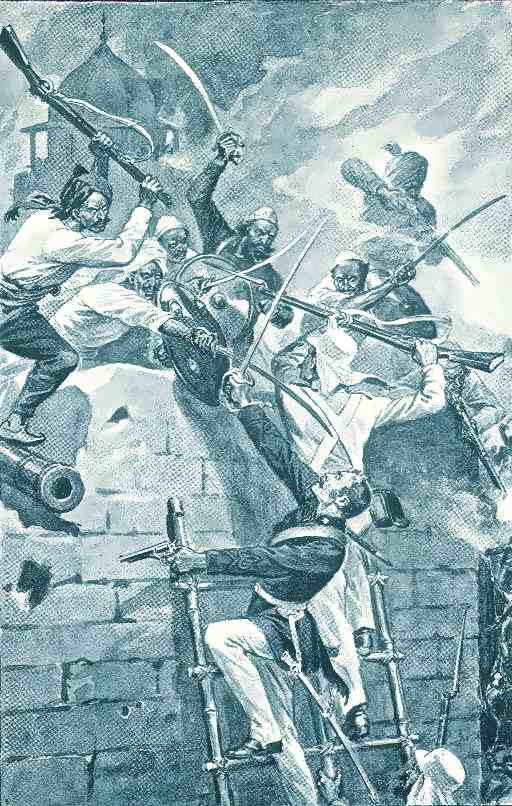 |
| They were to contain the enemy at Lucknow. The Ferozepore Regiment
was included in General Outram's force and held defensive works at
Alambagh for three months. Duties were very arduous on account of the
large perimeter to be held. while the enemy kept in constant touch and
there were almost daily skirmishes and minor encounters. The enemy
delivered a number of attacks, but these were all beaten off. |
|

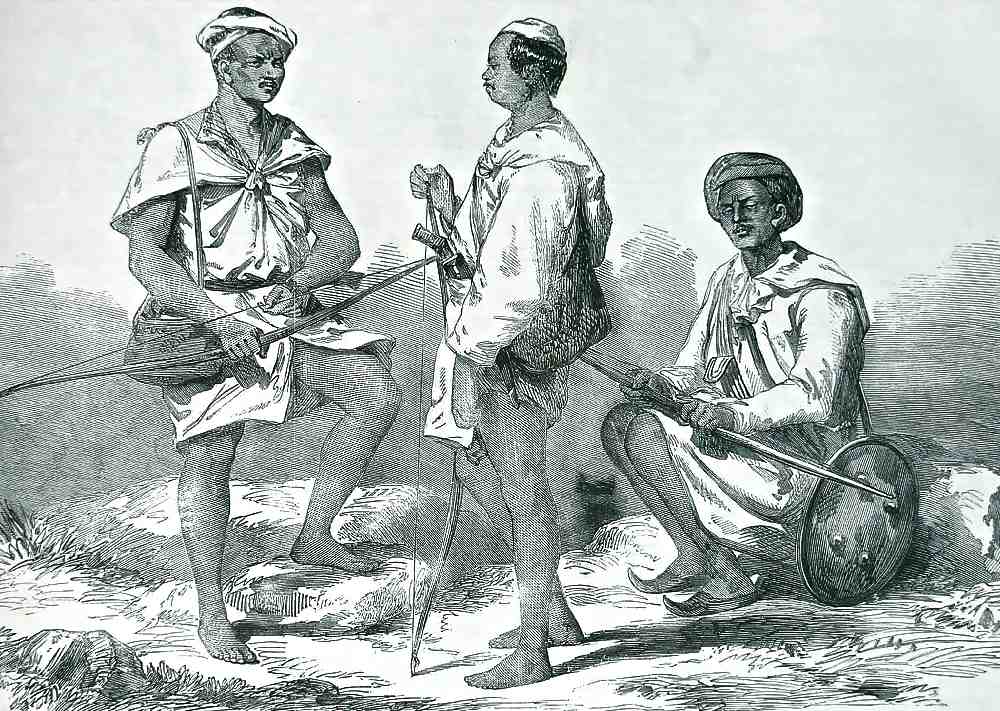
Gurkhas 66th Regiment |
The women and children brought from Lucknow once safe, the
commander-in-chief was able to direct his attention to the work before
him of clearing out of Cawnpore the rebel army, composed of the Gwalior
contingent, and the troops of Koer Sing and Nana Sahib, in all
twenty-five thousand men. Against this large force he could only bring
seventy-five hundred men.
When the threatening army of Gwalior was beaten and scattered, and
Cawnpore in British hands. Sir Colin Campbell was able to devote his
whole attention to clearing the country in his rear, and in preparing
for the great final campaign against Lucknow, which, now that Delhi had
fallen, was the headquarters of the mutiny.
During the previous two months large reinforcements had arrived, and
Jung Bahadoor, Prince of Nepal, had come down with an army of ten
thousand Gurkas.
After clearing the area of Mutineers, Campbell, in
March, 1858, reinforced by the Gurkha troops sent by the King of
Nepal, the Commander-in-Chief of the British forces in India marched
towards Lucknow at the head of English and Gurkha soldiers, and a
tremendous train of artillery, ammunition and stores, collected for the
attack upon the city. |
|
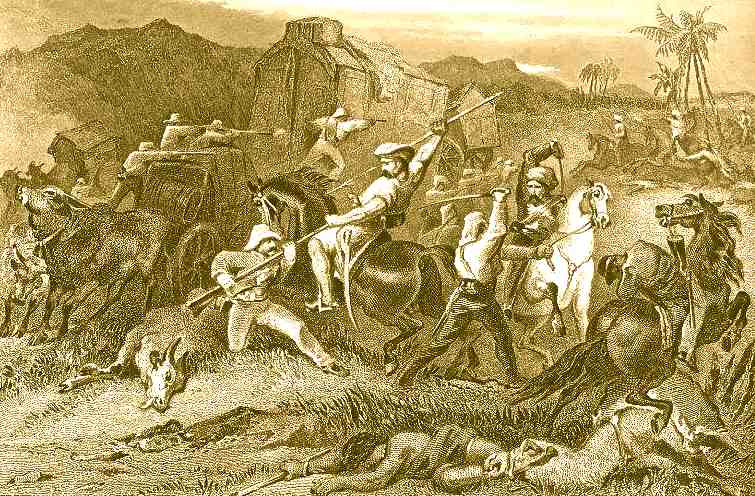
Rebel Sepoys - 1858 |
The task before the British forces was a difficult one. From all the
various points from which the British had driven them; from Delhi, from
Kohilcund, and the Doab, from Cawnpore, Furruckabad, Futtyghur, Etawah,
Allyghur, Goruckpore, and other places, they retreated to Lucknow, and
there were now collected sixty thousand revolted Sepoys and fifty
thousand irregular troops, besides the armed rabble of the city of three
hundred thousand souls.
Knowing the storm that was preparing to burst upon their heads, they had
neglected no means for strengthening their position. Great lines of
fortifications had been thrown up, enormous quantities of guns placed in
position, every house barricaded and loop-holed, and the Kaiser Bagh
transformed into a veritable citadel.At the beginning of March, 1858,
Sir Colin Campbell's force, joined General Outram at Alambagh and
started methodical operations against the rebels at Lucknow. The Sepoys
were holding three lines of defenses north of the city covering the
Kaiser Bagh, their citadel. These had been strengthened since the relief
of the Residency, and houses were now fortified and roads barricaded.
On March 3rd, 1858, the advanced division occupied the Dil I'loosha,
meeting with but slight resistance, and General Campbell at once took up
his headquarters there. The next three days were spent in making the
necessary disposition for a simultaneous attack upon all sides of the
town—General Outram on one side, Sir Hope Grant upon another, Jung
Bahadoor, with his Nepaulese, on the third, and the main attack, under
Sir Colin Campbell himself, on the fourth. The cavalry will not go into
the city, but will wait outside to cut off the enemy's retreat.
The fighting began with General Outram's division, which worked round
the city, and had on the 7th, 8th, and 9th, to repulse heavy attacks of
the enemy. |
|
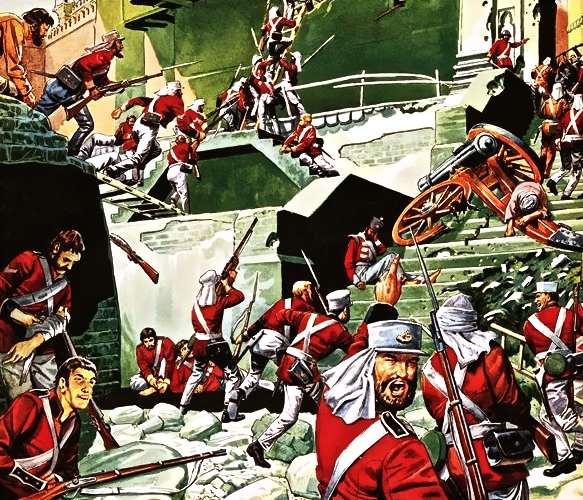 |
| On the 9th Sir Colin Campbell advanced, took the Martiniere with but
slight opposition, crossed the canal, and occupied the Sikander Bagh—the
scene of the tremendous fighting previously. Tlia Begum's
Palace, in front of Bank House, was then attacked, and after very heavy
fighting carried. Here Major Hodgson, the captor of the King Delhi, was
mortally wounded.
Day by day the troops fought their way forward, and on the 14th, the
Imaumbarra, a splendid palace of the King of Oude, adjoining the Kaiser
Bagh, was breached and carried under terrible fire, by the Sikhs and the
90th Light Infantry, led by Captains Brasyer and Havelock (Son of
General Havelock). The panic-struck defenders fled through
the court and garden into the Kaiser Bagh, followed hotly by the Sikhs,
Gurkhas, and Highlanders. Such was the terror which their appearance
excited that a panic seized also the defenders of the Kaiser Bagh, and
these too fled, deserting the fortifications raised with so much care,
and the British poured into the palace. For a few minutes a sharp
conflict took place in every room, and then the Sepoys being
annihilated, the victors fell upon the spoil. |
|
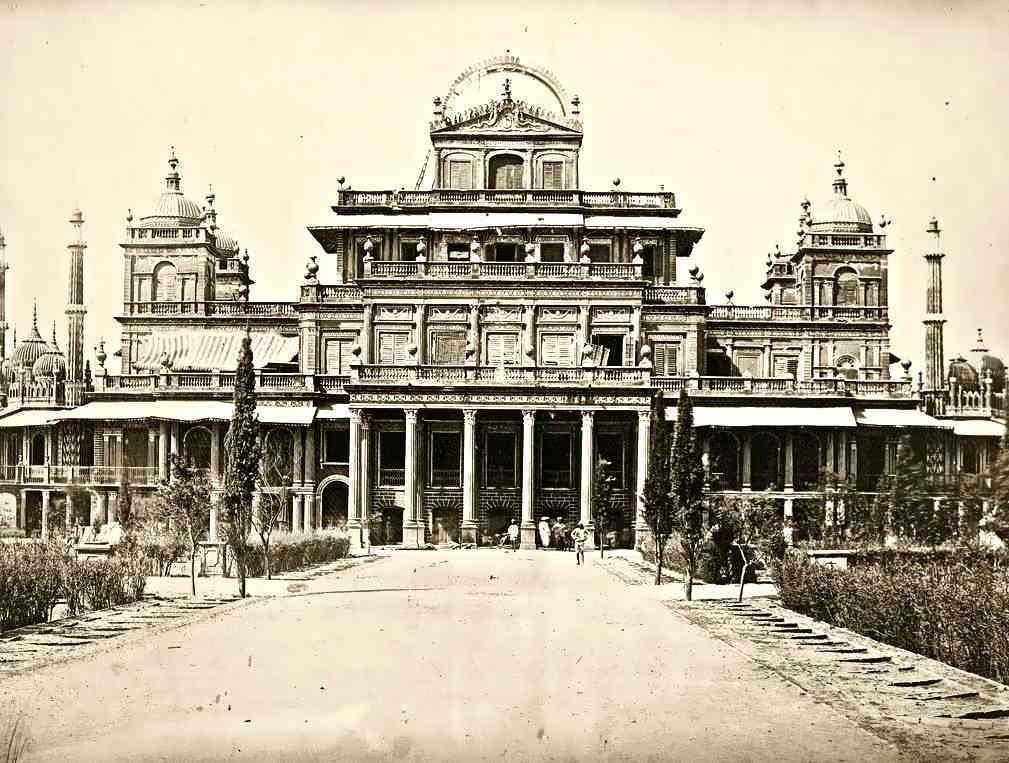
Kaiser Bagh_1858 |
From top to bottom the Kaiser Bagh was crowded with valuable
articles, collected from all parts of the world. English furniture,
French clocks and looking-glasses, Chinese porcelain, gorgeous
draperies, golden thrones studded with jewels, costly weapons inlaid
with gold, enormous quantities of jewelry, and wealth of all kinds to an
almost fabulous value.
The wildest scene of confusion ensued. According to the rule in these
matters, being taken by storm the place was lawful plunder. For large
things the soldiers did not care, and set-to to smash and destroy all
that could not be carried away. Some put on the turbans studded with
jewels; others hung necklaces of enormous value round their necks, or
covered their arms with bracelets. |
|
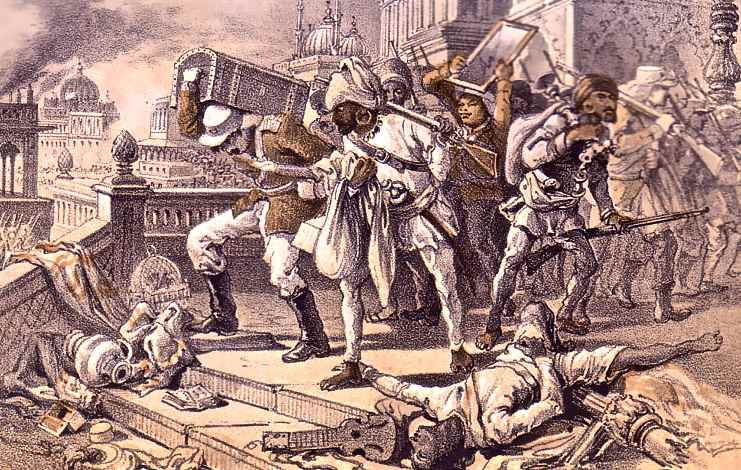
Plundering the Kaiser Bagh |
The fall of the Kaiser Bagh utterly demoralized the Mutineers, and from
that moment they began to leave the town by night in thousands. Numbers
were cut off and slaughtered by the British cavalry and artillery, but
large bodies succeeded in escaping to give fresh trouble in the
field.
Day by day the troops fought their way from palace to palace, and from
street to street. Day and night the cannon and mortar batteries
thundered against the districts of the city still uncaptured, and great
fires blazed in a dozen quarters. On March 16th, 1858, the Sikhs formed
part of General Outram's force, which captured the Residency and the
iron bridge. The ruined Residency was to be cleared of its debris,
replanted with trees, and to be left as a memorial of British valor, as
the rebels had been completely defeated in these battles and Lucknow was
once again safely in British hands.
It was not until a week after the storming of the Kaiser Bagh, by which
time everything had settled down, order was restored, and the
inhabitants were, under the direction of the military authorities,
engaged in clearing away rubbish, leveling barricades, and razing to the
ground a considerable portion of the city.
A great multitude of the teeming population of Lucknow had fled, and the
whole city outside the original town was to be cleared away and laid out
in gardens, so that henceforth Lucknow would be little more than a fifth
of its former size.There were still considerably more than one
hundred thousand of the enemy scattered in large bodies over the
country. There were a number of encounters in rounding up parties of
rebels and pacifying the countryside.
|
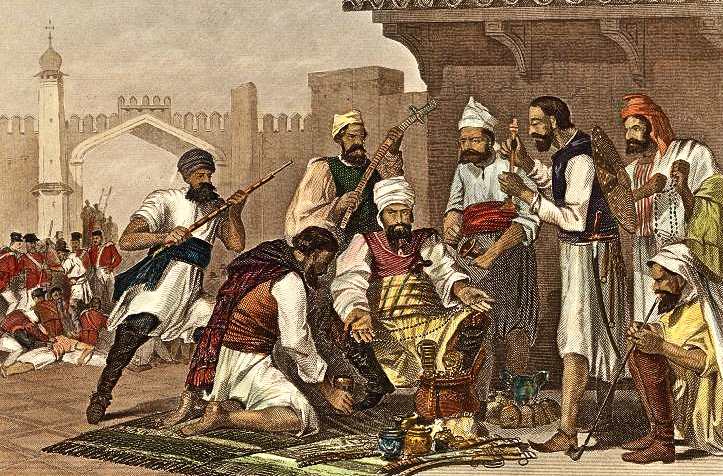
Sikh Troops Looting_1859
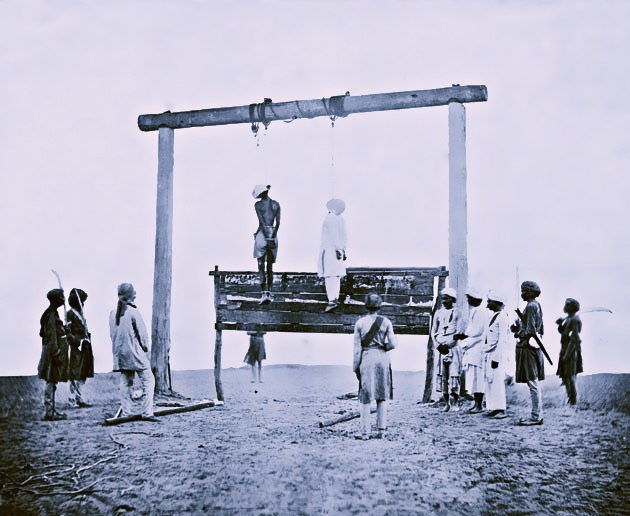
Execution of Rebels |
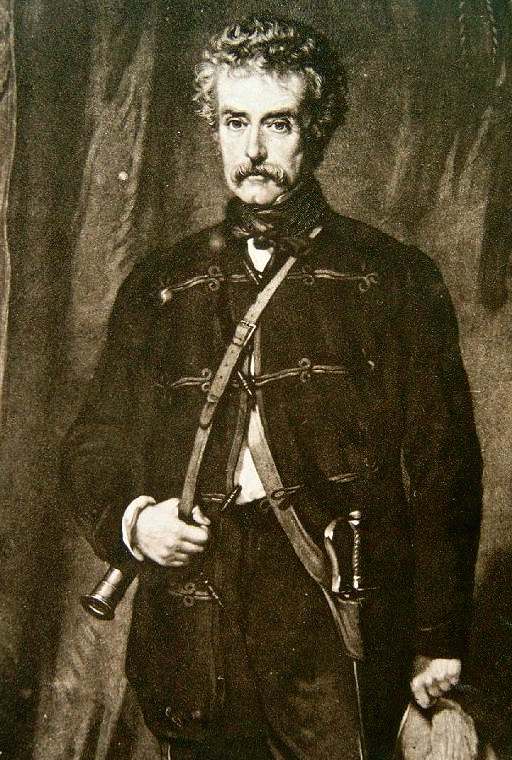
Sir Colin Campbell |
|
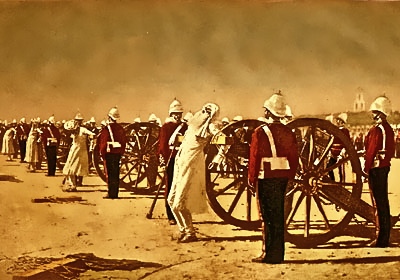
The Mutiny was not completely put down until the end of 1859. But the
insurrection had revealed such a terrible state of affairs. A transfer of 800,000
square miles and 200 million people to the Crown, was announced by Royal
Proclamation at Government House, Calcutta, on November 1st, 1858, and
in all districts and towns of India. The Governor General, Lord Canning,
was appointed first Viceroy.
In the Proclamation, Queen Victoria intimated that she had assumed
the direct government of India, and the East India Company, after a
duration of over 250 years, ceased to exist. The troops in the Company’s
service were to be transferred to that of the Crown, and the distinction
between Royal Troops and the East India Company’s European Troops, which
had existed for over 100 years, was to disappear. |
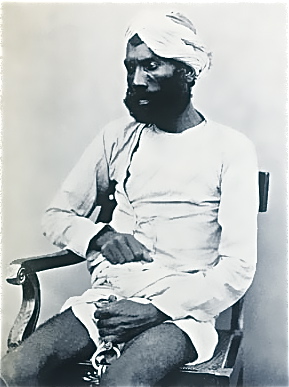
A hand-written caption identifies
the man above as Gungoo Mehter who was tried at Cawmpore for killing
many of the Sati Chaura survivors, including many women and children.
He was convicted and
hanged at Cawnpore on
September 8th, 1859 |
|
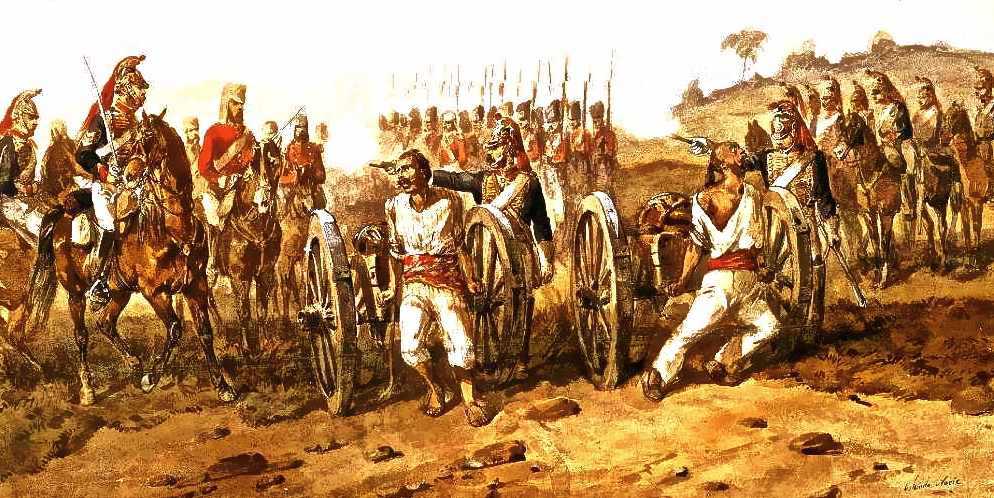
Blowing the Mutineers From the Guns |
|